Role of Leadership in Sustaining Healthcare Workforce during COVID-19
VerifiedAdded on 2023/01/06
|33
|10356
|30
AI Summary
This research project focuses on the role of leadership in sustaining the healthcare workforce during the COVID-19 pandemic. It explores the key elements of leadership within healthcare and examines the challenges faced by healthcare leadership in supporting the workforce during this crisis. The study aims to identify the role of leadership in providing proper guidance and support to healthcare workers and improving patient care. The research is conducted in collaboration with the British Medical Association.
Contribute Materials
Your contribution can guide someone’s learning journey. Share your
documents today.
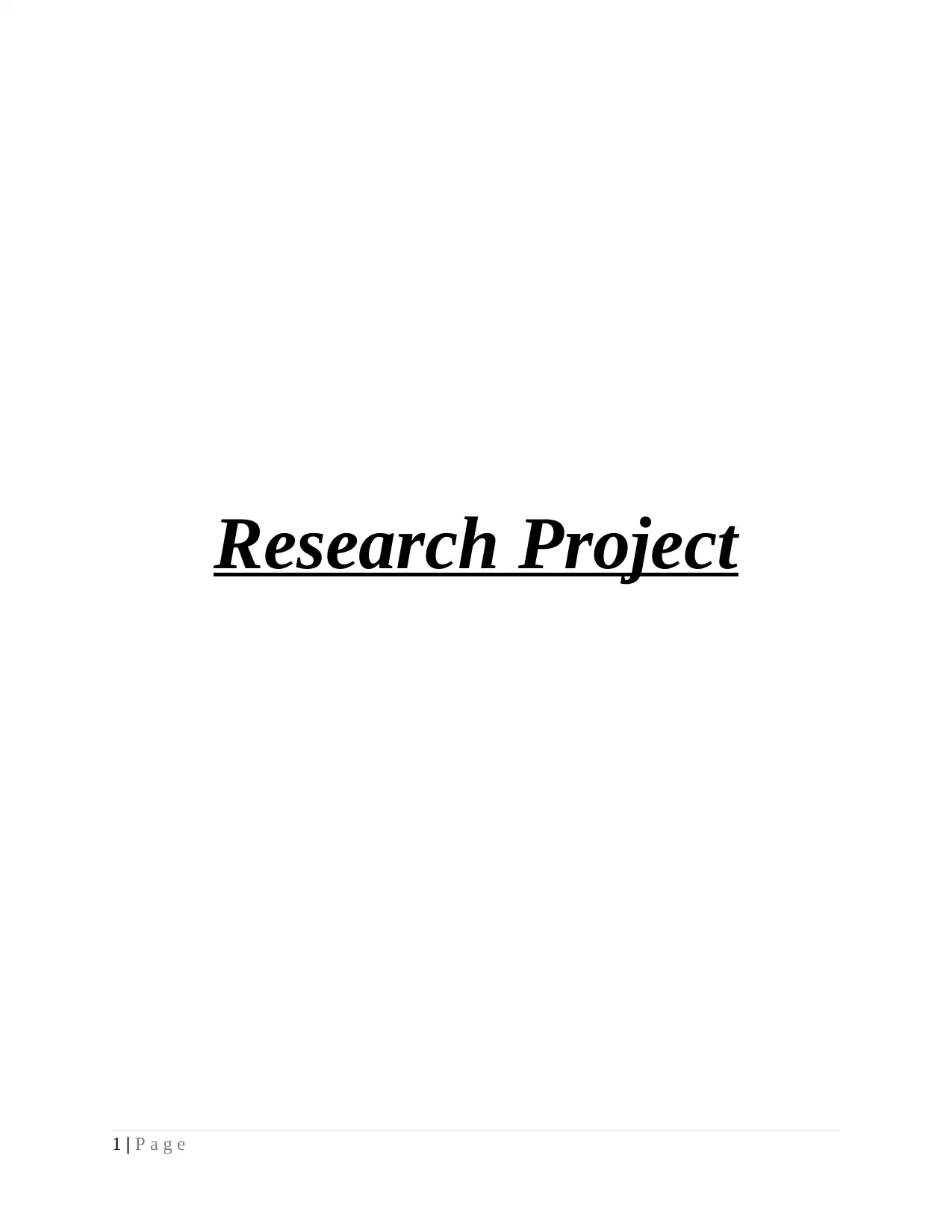
Research Project
1 | P a g e
1 | P a g e
Secure Best Marks with AI Grader
Need help grading? Try our AI Grader for instant feedback on your assignments.
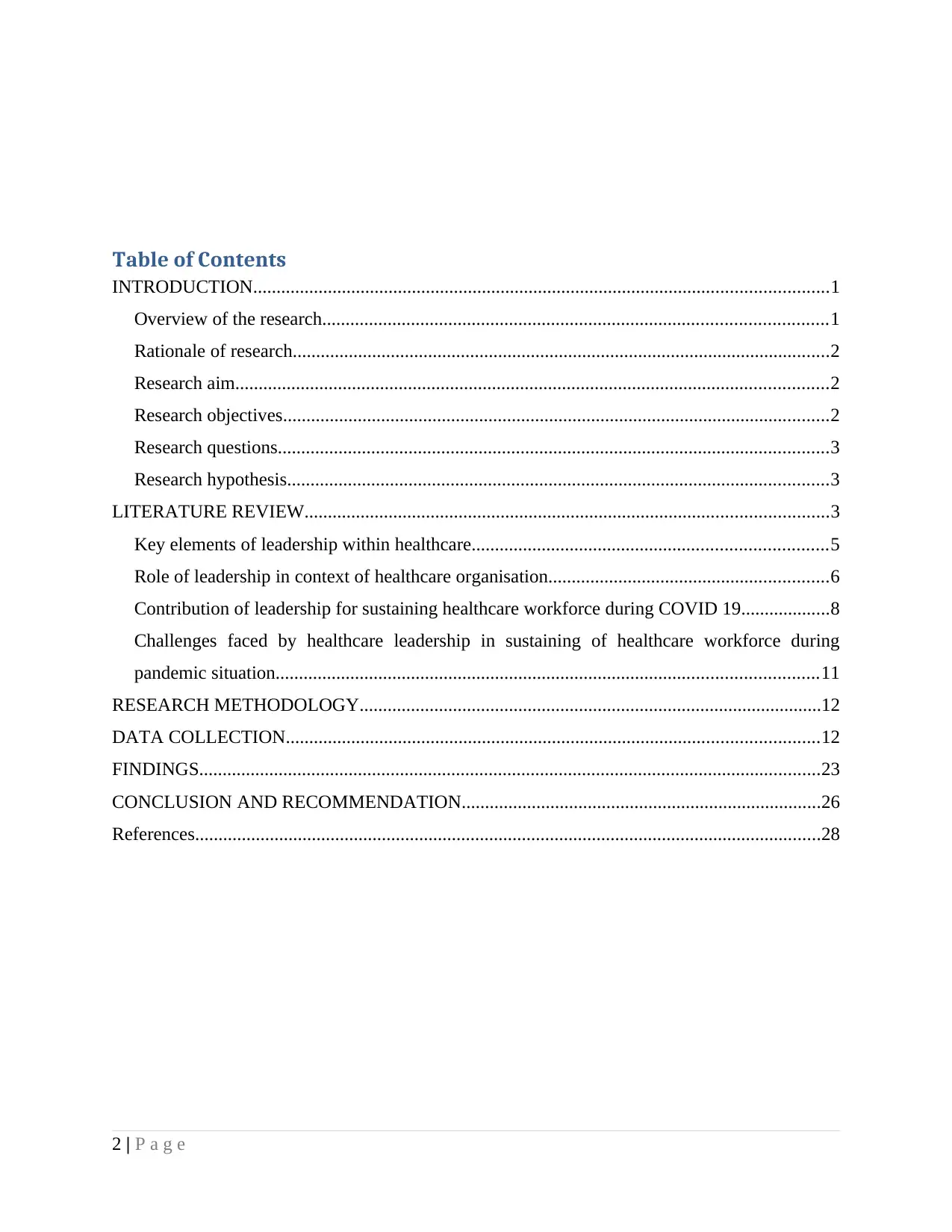
Table of Contents
INTRODUCTION...........................................................................................................................1
Overview of the research............................................................................................................1
Rationale of research...................................................................................................................2
Research aim...............................................................................................................................2
Research objectives.....................................................................................................................2
Research questions......................................................................................................................3
Research hypothesis....................................................................................................................3
LITERATURE REVIEW................................................................................................................3
Key elements of leadership within healthcare............................................................................5
Role of leadership in context of healthcare organisation............................................................6
Contribution of leadership for sustaining healthcare workforce during COVID 19...................8
Challenges faced by healthcare leadership in sustaining of healthcare workforce during
pandemic situation....................................................................................................................11
RESEARCH METHODOLOGY...................................................................................................12
DATA COLLECTION..................................................................................................................12
FINDINGS.....................................................................................................................................23
CONCLUSION AND RECOMMENDATION.............................................................................26
References......................................................................................................................................28
2 | P a g e
INTRODUCTION...........................................................................................................................1
Overview of the research............................................................................................................1
Rationale of research...................................................................................................................2
Research aim...............................................................................................................................2
Research objectives.....................................................................................................................2
Research questions......................................................................................................................3
Research hypothesis....................................................................................................................3
LITERATURE REVIEW................................................................................................................3
Key elements of leadership within healthcare............................................................................5
Role of leadership in context of healthcare organisation............................................................6
Contribution of leadership for sustaining healthcare workforce during COVID 19...................8
Challenges faced by healthcare leadership in sustaining of healthcare workforce during
pandemic situation....................................................................................................................11
RESEARCH METHODOLOGY...................................................................................................12
DATA COLLECTION..................................................................................................................12
FINDINGS.....................................................................................................................................23
CONCLUSION AND RECOMMENDATION.............................................................................26
References......................................................................................................................................28
2 | P a g e

3 | P a g e
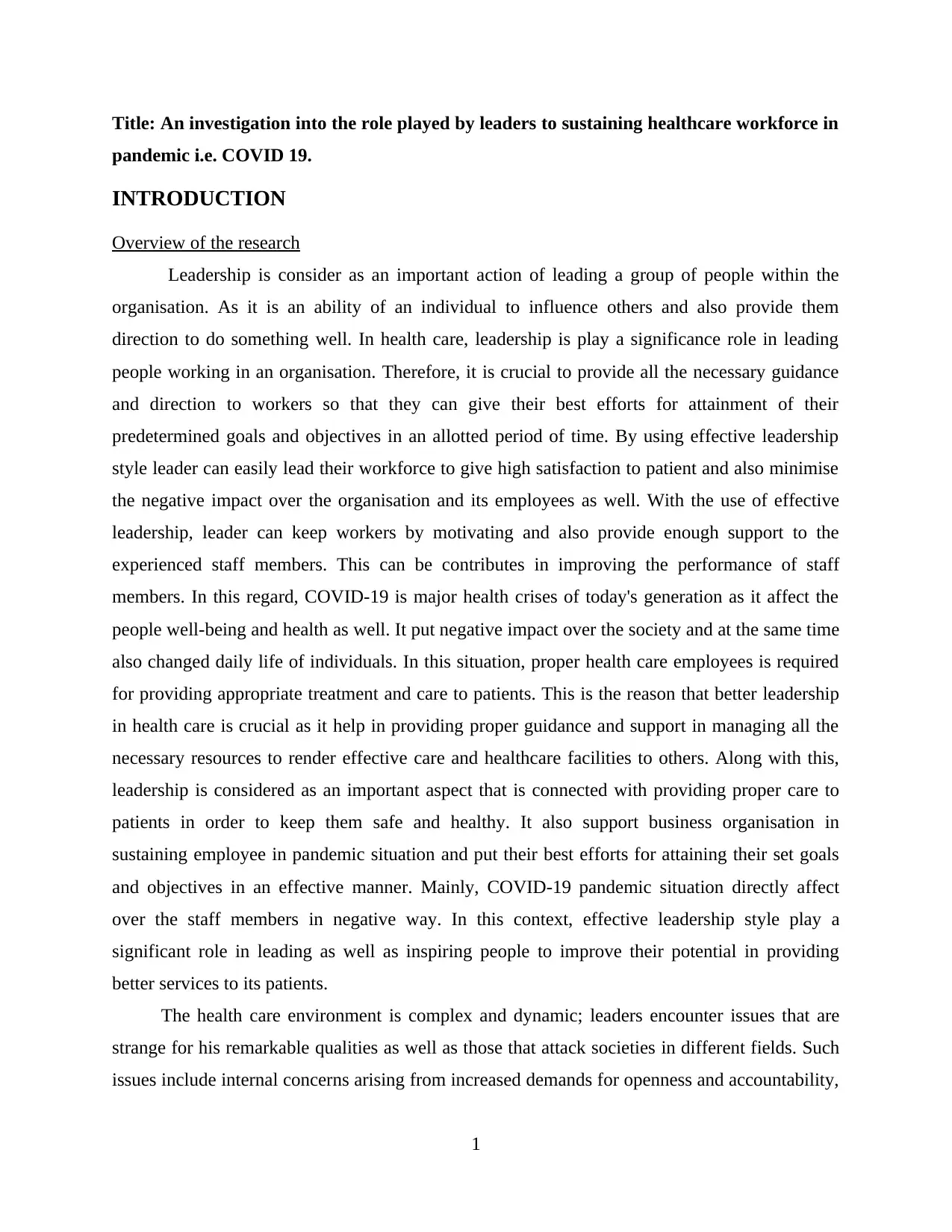
Title: An investigation into the role played by leaders to sustaining healthcare workforce in
pandemic i.e. COVID 19.
INTRODUCTION
Overview of the research
Leadership is consider as an important action of leading a group of people within the
organisation. As it is an ability of an individual to influence others and also provide them
direction to do something well. In health care, leadership is play a significance role in leading
people working in an organisation. Therefore, it is crucial to provide all the necessary guidance
and direction to workers so that they can give their best efforts for attainment of their
predetermined goals and objectives in an allotted period of time. By using effective leadership
style leader can easily lead their workforce to give high satisfaction to patient and also minimise
the negative impact over the organisation and its employees as well. With the use of effective
leadership, leader can keep workers by motivating and also provide enough support to the
experienced staff members. This can be contributes in improving the performance of staff
members. In this regard, COVID-19 is major health crises of today's generation as it affect the
people well-being and health as well. It put negative impact over the society and at the same time
also changed daily life of individuals. In this situation, proper health care employees is required
for providing appropriate treatment and care to patients. This is the reason that better leadership
in health care is crucial as it help in providing proper guidance and support in managing all the
necessary resources to render effective care and healthcare facilities to others. Along with this,
leadership is considered as an important aspect that is connected with providing proper care to
patients in order to keep them safe and healthy. It also support business organisation in
sustaining employee in pandemic situation and put their best efforts for attaining their set goals
and objectives in an effective manner. Mainly, COVID-19 pandemic situation directly affect
over the staff members in negative way. In this context, effective leadership style play a
significant role in leading as well as inspiring people to improve their potential in providing
better services to its patients.
The health care environment is complex and dynamic; leaders encounter issues that are
strange for his remarkable qualities as well as those that attack societies in different fields. Such
issues include internal concerns arising from increased demands for openness and accountability,
1
pandemic i.e. COVID 19.
INTRODUCTION
Overview of the research
Leadership is consider as an important action of leading a group of people within the
organisation. As it is an ability of an individual to influence others and also provide them
direction to do something well. In health care, leadership is play a significance role in leading
people working in an organisation. Therefore, it is crucial to provide all the necessary guidance
and direction to workers so that they can give their best efforts for attainment of their
predetermined goals and objectives in an allotted period of time. By using effective leadership
style leader can easily lead their workforce to give high satisfaction to patient and also minimise
the negative impact over the organisation and its employees as well. With the use of effective
leadership, leader can keep workers by motivating and also provide enough support to the
experienced staff members. This can be contributes in improving the performance of staff
members. In this regard, COVID-19 is major health crises of today's generation as it affect the
people well-being and health as well. It put negative impact over the society and at the same time
also changed daily life of individuals. In this situation, proper health care employees is required
for providing appropriate treatment and care to patients. This is the reason that better leadership
in health care is crucial as it help in providing proper guidance and support in managing all the
necessary resources to render effective care and healthcare facilities to others. Along with this,
leadership is considered as an important aspect that is connected with providing proper care to
patients in order to keep them safe and healthy. It also support business organisation in
sustaining employee in pandemic situation and put their best efforts for attaining their set goals
and objectives in an effective manner. Mainly, COVID-19 pandemic situation directly affect
over the staff members in negative way. In this context, effective leadership style play a
significant role in leading as well as inspiring people to improve their potential in providing
better services to its patients.
The health care environment is complex and dynamic; leaders encounter issues that are
strange for his remarkable qualities as well as those that attack societies in different fields. Such
issues include internal concerns arising from increased demands for openness and accountability,
1
Secure Best Marks with AI Grader
Need help grading? Try our AI Grader for instant feedback on your assignments.
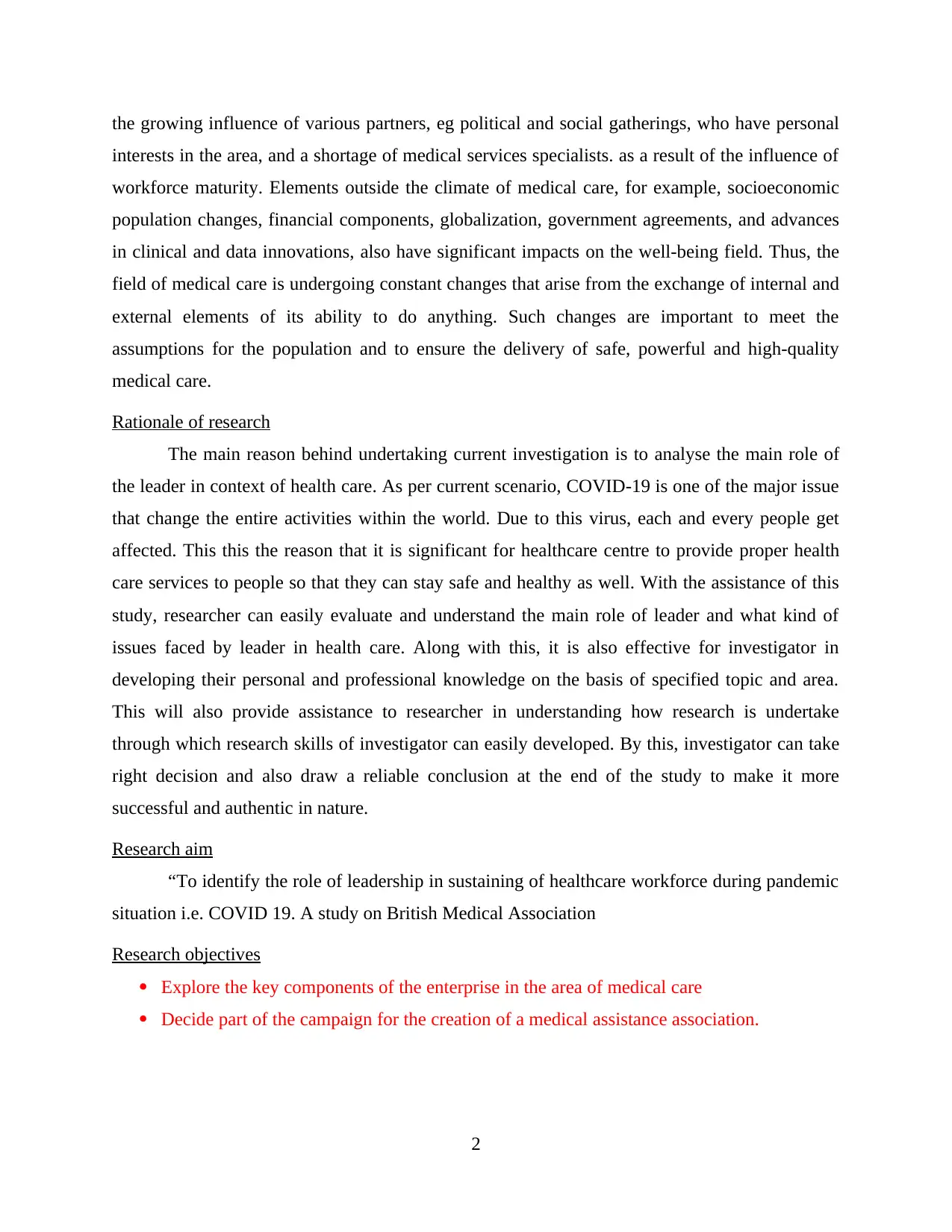
the growing influence of various partners, eg political and social gatherings, who have personal
interests in the area, and a shortage of medical services specialists. as a result of the influence of
workforce maturity. Elements outside the climate of medical care, for example, socioeconomic
population changes, financial components, globalization, government agreements, and advances
in clinical and data innovations, also have significant impacts on the well-being field. Thus, the
field of medical care is undergoing constant changes that arise from the exchange of internal and
external elements of its ability to do anything. Such changes are important to meet the
assumptions for the population and to ensure the delivery of safe, powerful and high-quality
medical care.
Rationale of research
The main reason behind undertaking current investigation is to analyse the main role of
the leader in context of health care. As per current scenario, COVID-19 is one of the major issue
that change the entire activities within the world. Due to this virus, each and every people get
affected. This this the reason that it is significant for healthcare centre to provide proper health
care services to people so that they can stay safe and healthy as well. With the assistance of this
study, researcher can easily evaluate and understand the main role of leader and what kind of
issues faced by leader in health care. Along with this, it is also effective for investigator in
developing their personal and professional knowledge on the basis of specified topic and area.
This will also provide assistance to researcher in understanding how research is undertake
through which research skills of investigator can easily developed. By this, investigator can take
right decision and also draw a reliable conclusion at the end of the study to make it more
successful and authentic in nature.
Research aim
“To identify the role of leadership in sustaining of healthcare workforce during pandemic
situation i.e. COVID 19. A study on British Medical Association
Research objectives
Explore the key components of the enterprise in the area of medical care
Decide part of the campaign for the creation of a medical assistance association.
2
interests in the area, and a shortage of medical services specialists. as a result of the influence of
workforce maturity. Elements outside the climate of medical care, for example, socioeconomic
population changes, financial components, globalization, government agreements, and advances
in clinical and data innovations, also have significant impacts on the well-being field. Thus, the
field of medical care is undergoing constant changes that arise from the exchange of internal and
external elements of its ability to do anything. Such changes are important to meet the
assumptions for the population and to ensure the delivery of safe, powerful and high-quality
medical care.
Rationale of research
The main reason behind undertaking current investigation is to analyse the main role of
the leader in context of health care. As per current scenario, COVID-19 is one of the major issue
that change the entire activities within the world. Due to this virus, each and every people get
affected. This this the reason that it is significant for healthcare centre to provide proper health
care services to people so that they can stay safe and healthy as well. With the assistance of this
study, researcher can easily evaluate and understand the main role of leader and what kind of
issues faced by leader in health care. Along with this, it is also effective for investigator in
developing their personal and professional knowledge on the basis of specified topic and area.
This will also provide assistance to researcher in understanding how research is undertake
through which research skills of investigator can easily developed. By this, investigator can take
right decision and also draw a reliable conclusion at the end of the study to make it more
successful and authentic in nature.
Research aim
“To identify the role of leadership in sustaining of healthcare workforce during pandemic
situation i.e. COVID 19. A study on British Medical Association
Research objectives
Explore the key components of the enterprise in the area of medical care
Decide part of the campaign for the creation of a medical assistance association.
2
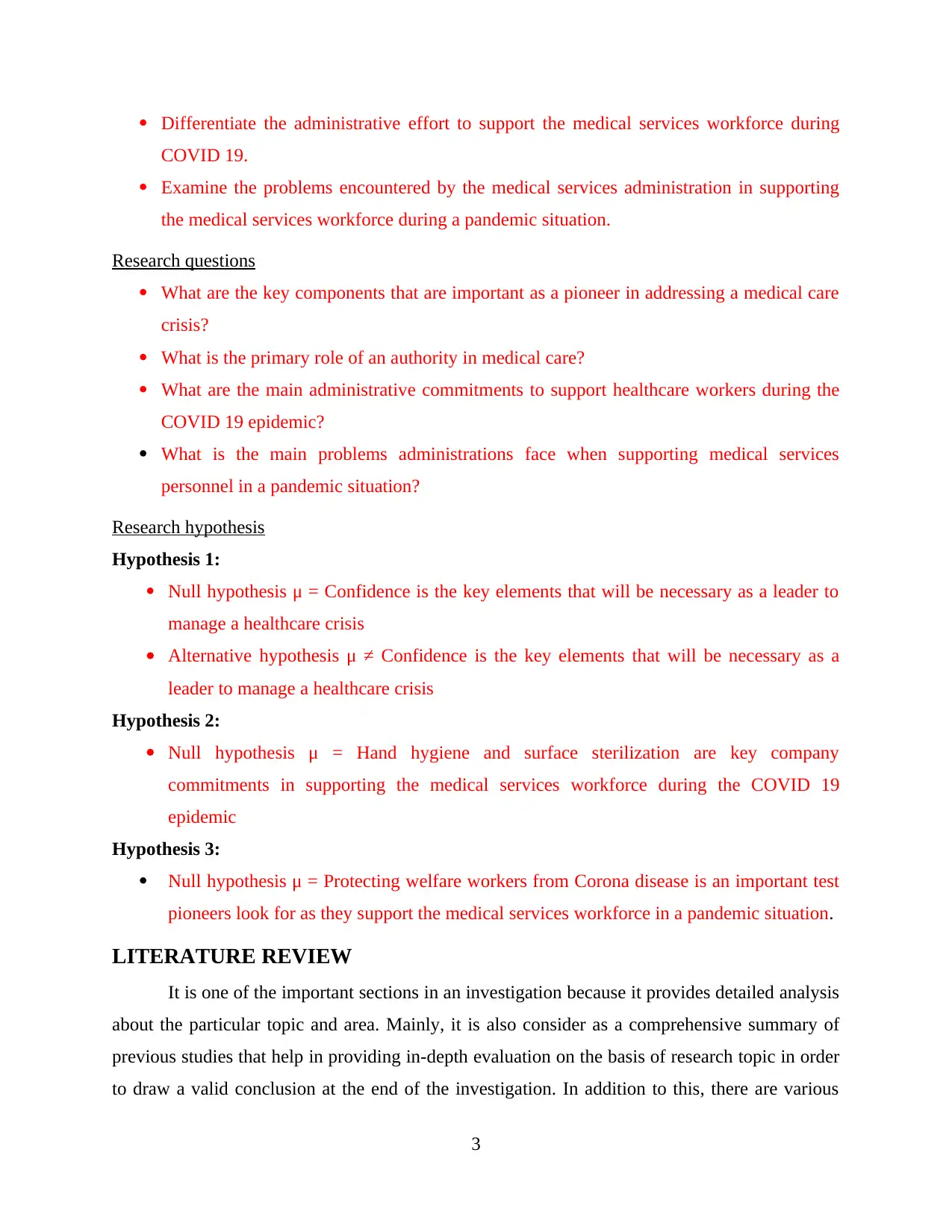
Differentiate the administrative effort to support the medical services workforce during
COVID 19.
Examine the problems encountered by the medical services administration in supporting
the medical services workforce during a pandemic situation.
Research questions
What are the key components that are important as a pioneer in addressing a medical care
crisis?
What is the primary role of an authority in medical care?
What are the main administrative commitments to support healthcare workers during the
COVID 19 epidemic?
What is the main problems administrations face when supporting medical services
personnel in a pandemic situation?
Research hypothesis
Hypothesis 1:
Null hypothesis μ = Confidence is the key elements that will be necessary as a leader to
manage a healthcare crisis
Alternative hypothesis μ ≠ Confidence is the key elements that will be necessary as a
leader to manage a healthcare crisis
Hypothesis 2:
Null hypothesis μ = Hand hygiene and surface sterilization are key company
commitments in supporting the medical services workforce during the COVID 19
epidemic
Hypothesis 3:
Null hypothesis μ = Protecting welfare workers from Corona disease is an important test
pioneers look for as they support the medical services workforce in a pandemic situation.
LITERATURE REVIEW
It is one of the important sections in an investigation because it provides detailed analysis
about the particular topic and area. Mainly, it is also consider as a comprehensive summary of
previous studies that help in providing in-depth evaluation on the basis of research topic in order
to draw a valid conclusion at the end of the investigation. In addition to this, there are various
3
COVID 19.
Examine the problems encountered by the medical services administration in supporting
the medical services workforce during a pandemic situation.
Research questions
What are the key components that are important as a pioneer in addressing a medical care
crisis?
What is the primary role of an authority in medical care?
What are the main administrative commitments to support healthcare workers during the
COVID 19 epidemic?
What is the main problems administrations face when supporting medical services
personnel in a pandemic situation?
Research hypothesis
Hypothesis 1:
Null hypothesis μ = Confidence is the key elements that will be necessary as a leader to
manage a healthcare crisis
Alternative hypothesis μ ≠ Confidence is the key elements that will be necessary as a
leader to manage a healthcare crisis
Hypothesis 2:
Null hypothesis μ = Hand hygiene and surface sterilization are key company
commitments in supporting the medical services workforce during the COVID 19
epidemic
Hypothesis 3:
Null hypothesis μ = Protecting welfare workers from Corona disease is an important test
pioneers look for as they support the medical services workforce in a pandemic situation.
LITERATURE REVIEW
It is one of the important sections in an investigation because it provides detailed analysis
about the particular topic and area. Mainly, it is also consider as a comprehensive summary of
previous studies that help in providing in-depth evaluation on the basis of research topic in order
to draw a valid conclusion at the end of the investigation. In addition to this, there are various
3
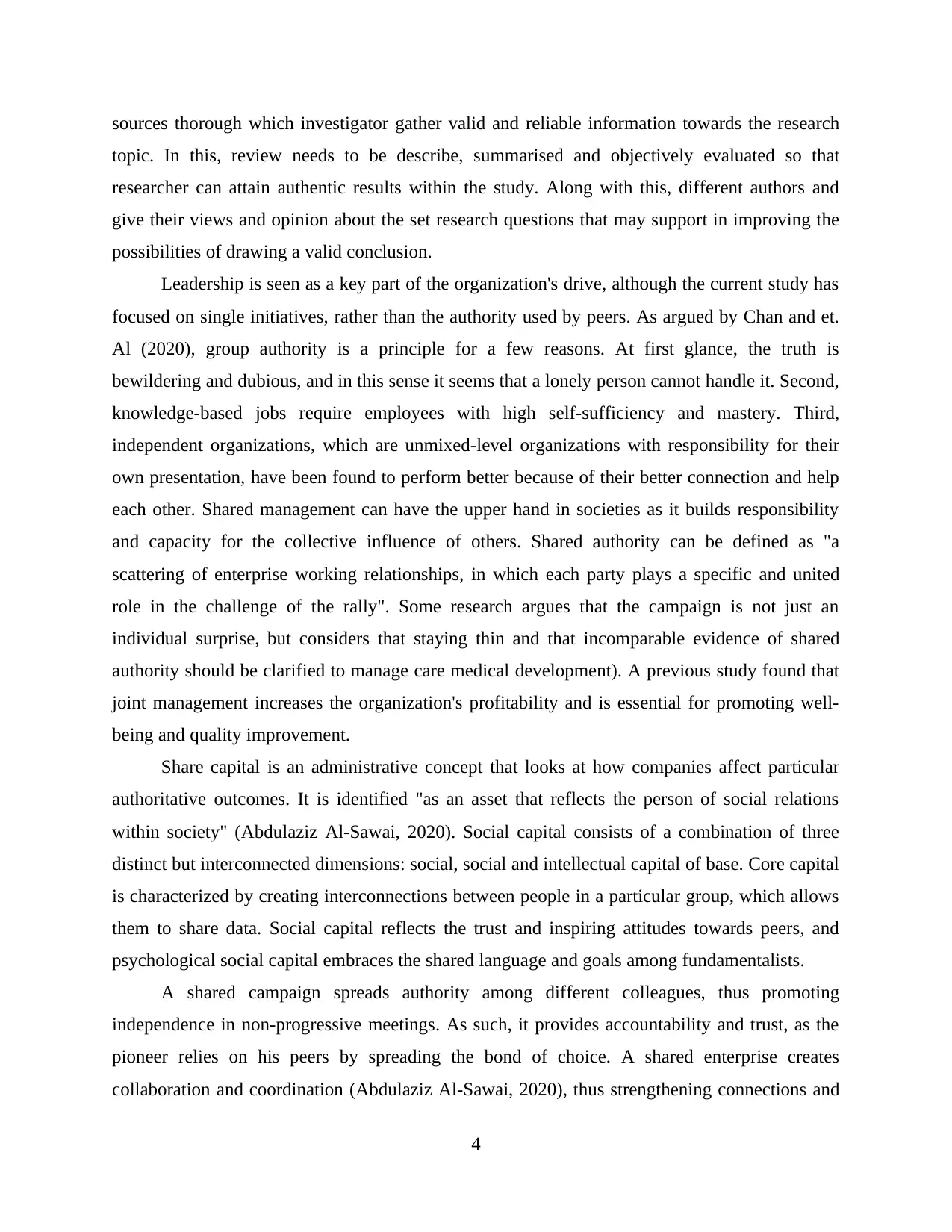
sources thorough which investigator gather valid and reliable information towards the research
topic. In this, review needs to be describe, summarised and objectively evaluated so that
researcher can attain authentic results within the study. Along with this, different authors and
give their views and opinion about the set research questions that may support in improving the
possibilities of drawing a valid conclusion.
Leadership is seen as a key part of the organization's drive, although the current study has
focused on single initiatives, rather than the authority used by peers. As argued by Chan and et.
Al (2020), group authority is a principle for a few reasons. At first glance, the truth is
bewildering and dubious, and in this sense it seems that a lonely person cannot handle it. Second,
knowledge-based jobs require employees with high self-sufficiency and mastery. Third,
independent organizations, which are unmixed-level organizations with responsibility for their
own presentation, have been found to perform better because of their better connection and help
each other. Shared management can have the upper hand in societies as it builds responsibility
and capacity for the collective influence of others. Shared authority can be defined as "a
scattering of enterprise working relationships, in which each party plays a specific and united
role in the challenge of the rally". Some research argues that the campaign is not just an
individual surprise, but considers that staying thin and that incomparable evidence of shared
authority should be clarified to manage care medical development). A previous study found that
joint management increases the organization's profitability and is essential for promoting well-
being and quality improvement.
Share capital is an administrative concept that looks at how companies affect particular
authoritative outcomes. It is identified "as an asset that reflects the person of social relations
within society" (Abdulaziz Al-Sawai, 2020). Social capital consists of a combination of three
distinct but interconnected dimensions: social, social and intellectual capital of base. Core capital
is characterized by creating interconnections between people in a particular group, which allows
them to share data. Social capital reflects the trust and inspiring attitudes towards peers, and
psychological social capital embraces the shared language and goals among fundamentalists.
A shared campaign spreads authority among different colleagues, thus promoting
independence in non-progressive meetings. As such, it provides accountability and trust, as the
pioneer relies on his peers by spreading the bond of choice. A shared enterprise creates
collaboration and coordination (Abdulaziz Al-Sawai, 2020), thus strengthening connections and
4
topic. In this, review needs to be describe, summarised and objectively evaluated so that
researcher can attain authentic results within the study. Along with this, different authors and
give their views and opinion about the set research questions that may support in improving the
possibilities of drawing a valid conclusion.
Leadership is seen as a key part of the organization's drive, although the current study has
focused on single initiatives, rather than the authority used by peers. As argued by Chan and et.
Al (2020), group authority is a principle for a few reasons. At first glance, the truth is
bewildering and dubious, and in this sense it seems that a lonely person cannot handle it. Second,
knowledge-based jobs require employees with high self-sufficiency and mastery. Third,
independent organizations, which are unmixed-level organizations with responsibility for their
own presentation, have been found to perform better because of their better connection and help
each other. Shared management can have the upper hand in societies as it builds responsibility
and capacity for the collective influence of others. Shared authority can be defined as "a
scattering of enterprise working relationships, in which each party plays a specific and united
role in the challenge of the rally". Some research argues that the campaign is not just an
individual surprise, but considers that staying thin and that incomparable evidence of shared
authority should be clarified to manage care medical development). A previous study found that
joint management increases the organization's profitability and is essential for promoting well-
being and quality improvement.
Share capital is an administrative concept that looks at how companies affect particular
authoritative outcomes. It is identified "as an asset that reflects the person of social relations
within society" (Abdulaziz Al-Sawai, 2020). Social capital consists of a combination of three
distinct but interconnected dimensions: social, social and intellectual capital of base. Core capital
is characterized by creating interconnections between people in a particular group, which allows
them to share data. Social capital reflects the trust and inspiring attitudes towards peers, and
psychological social capital embraces the shared language and goals among fundamentalists.
A shared campaign spreads authority among different colleagues, thus promoting
independence in non-progressive meetings. As such, it provides accountability and trust, as the
pioneer relies on his peers by spreading the bond of choice. A shared enterprise creates
collaboration and coordination (Abdulaziz Al-Sawai, 2020), thus strengthening connections and
4
Paraphrase This Document
Need a fresh take? Get an instant paraphrase of this document with our AI Paraphraser
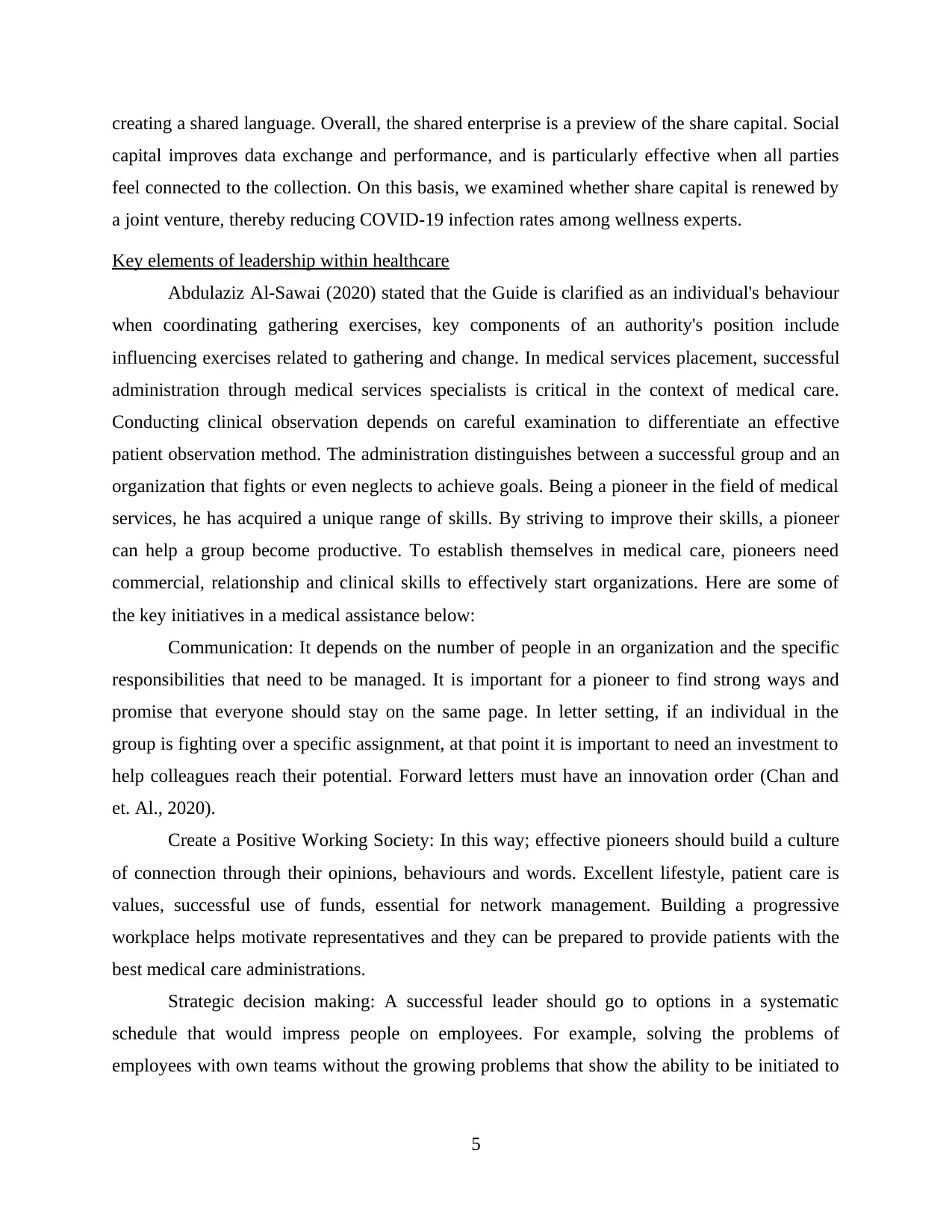
creating a shared language. Overall, the shared enterprise is a preview of the share capital. Social
capital improves data exchange and performance, and is particularly effective when all parties
feel connected to the collection. On this basis, we examined whether share capital is renewed by
a joint venture, thereby reducing COVID-19 infection rates among wellness experts.
Key elements of leadership within healthcare
Abdulaziz Al-Sawai (2020) stated that the Guide is clarified as an individual's behaviour
when coordinating gathering exercises, key components of an authority's position include
influencing exercises related to gathering and change. In medical services placement, successful
administration through medical services specialists is critical in the context of medical care.
Conducting clinical observation depends on careful examination to differentiate an effective
patient observation method. The administration distinguishes between a successful group and an
organization that fights or even neglects to achieve goals. Being a pioneer in the field of medical
services, he has acquired a unique range of skills. By striving to improve their skills, a pioneer
can help a group become productive. To establish themselves in medical care, pioneers need
commercial, relationship and clinical skills to effectively start organizations. Here are some of
the key initiatives in a medical assistance below:
Communication: It depends on the number of people in an organization and the specific
responsibilities that need to be managed. It is important for a pioneer to find strong ways and
promise that everyone should stay on the same page. In letter setting, if an individual in the
group is fighting over a specific assignment, at that point it is important to need an investment to
help colleagues reach their potential. Forward letters must have an innovation order (Chan and
et. Al., 2020).
Create a Positive Working Society: In this way; effective pioneers should build a culture
of connection through their opinions, behaviours and words. Excellent lifestyle, patient care is
values, successful use of funds, essential for network management. Building a progressive
workplace helps motivate representatives and they can be prepared to provide patients with the
best medical care administrations.
Strategic decision making: A successful leader should go to options in a systematic
schedule that would impress people on employees. For example, solving the problems of
employees with own teams without the growing problems that show the ability to be initiated to
5
capital improves data exchange and performance, and is particularly effective when all parties
feel connected to the collection. On this basis, we examined whether share capital is renewed by
a joint venture, thereby reducing COVID-19 infection rates among wellness experts.
Key elements of leadership within healthcare
Abdulaziz Al-Sawai (2020) stated that the Guide is clarified as an individual's behaviour
when coordinating gathering exercises, key components of an authority's position include
influencing exercises related to gathering and change. In medical services placement, successful
administration through medical services specialists is critical in the context of medical care.
Conducting clinical observation depends on careful examination to differentiate an effective
patient observation method. The administration distinguishes between a successful group and an
organization that fights or even neglects to achieve goals. Being a pioneer in the field of medical
services, he has acquired a unique range of skills. By striving to improve their skills, a pioneer
can help a group become productive. To establish themselves in medical care, pioneers need
commercial, relationship and clinical skills to effectively start organizations. Here are some of
the key initiatives in a medical assistance below:
Communication: It depends on the number of people in an organization and the specific
responsibilities that need to be managed. It is important for a pioneer to find strong ways and
promise that everyone should stay on the same page. In letter setting, if an individual in the
group is fighting over a specific assignment, at that point it is important to need an investment to
help colleagues reach their potential. Forward letters must have an innovation order (Chan and
et. Al., 2020).
Create a Positive Working Society: In this way; effective pioneers should build a culture
of connection through their opinions, behaviours and words. Excellent lifestyle, patient care is
values, successful use of funds, essential for network management. Building a progressive
workplace helps motivate representatives and they can be prepared to provide patients with the
best medical care administrations.
Strategic decision making: A successful leader should go to options in a systematic
schedule that would impress people on employees. For example, solving the problems of
employees with own teams without the growing problems that show the ability to be initiated to
5
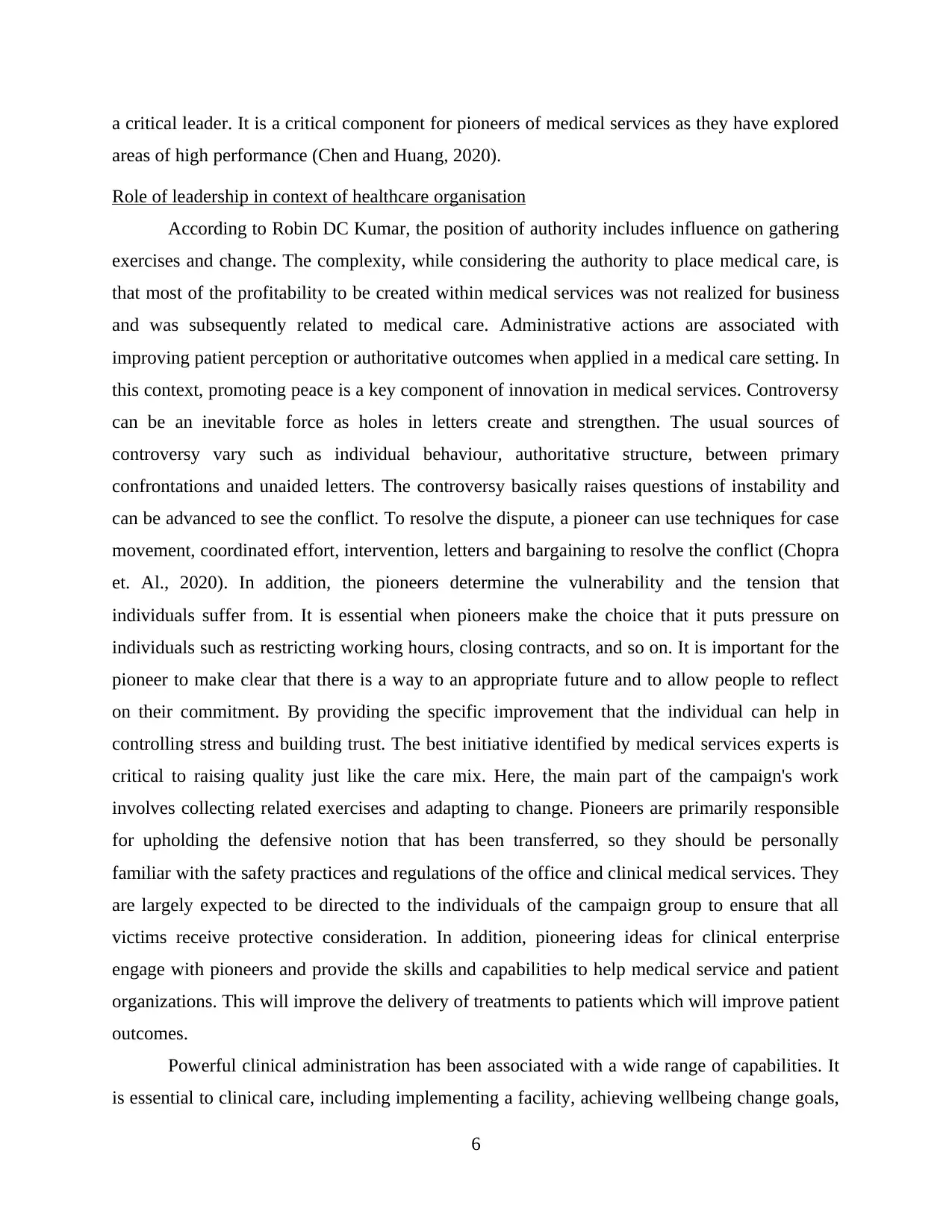
a critical leader. It is a critical component for pioneers of medical services as they have explored
areas of high performance (Chen and Huang, 2020).
Role of leadership in context of healthcare organisation
According to Robin DC Kumar, the position of authority includes influence on gathering
exercises and change. The complexity, while considering the authority to place medical care, is
that most of the profitability to be created within medical services was not realized for business
and was subsequently related to medical care. Administrative actions are associated with
improving patient perception or authoritative outcomes when applied in a medical care setting. In
this context, promoting peace is a key component of innovation in medical services. Controversy
can be an inevitable force as holes in letters create and strengthen. The usual sources of
controversy vary such as individual behaviour, authoritative structure, between primary
confrontations and unaided letters. The controversy basically raises questions of instability and
can be advanced to see the conflict. To resolve the dispute, a pioneer can use techniques for case
movement, coordinated effort, intervention, letters and bargaining to resolve the conflict (Chopra
et. Al., 2020). In addition, the pioneers determine the vulnerability and the tension that
individuals suffer from. It is essential when pioneers make the choice that it puts pressure on
individuals such as restricting working hours, closing contracts, and so on. It is important for the
pioneer to make clear that there is a way to an appropriate future and to allow people to reflect
on their commitment. By providing the specific improvement that the individual can help in
controlling stress and building trust. The best initiative identified by medical services experts is
critical to raising quality just like the care mix. Here, the main part of the campaign's work
involves collecting related exercises and adapting to change. Pioneers are primarily responsible
for upholding the defensive notion that has been transferred, so they should be personally
familiar with the safety practices and regulations of the office and clinical medical services. They
are largely expected to be directed to the individuals of the campaign group to ensure that all
victims receive protective consideration. In addition, pioneering ideas for clinical enterprise
engage with pioneers and provide the skills and capabilities to help medical service and patient
organizations. This will improve the delivery of treatments to patients which will improve patient
outcomes.
Powerful clinical administration has been associated with a wide range of capabilities. It
is essential to clinical care, including implementing a facility, achieving wellbeing change goals,
6
areas of high performance (Chen and Huang, 2020).
Role of leadership in context of healthcare organisation
According to Robin DC Kumar, the position of authority includes influence on gathering
exercises and change. The complexity, while considering the authority to place medical care, is
that most of the profitability to be created within medical services was not realized for business
and was subsequently related to medical care. Administrative actions are associated with
improving patient perception or authoritative outcomes when applied in a medical care setting. In
this context, promoting peace is a key component of innovation in medical services. Controversy
can be an inevitable force as holes in letters create and strengthen. The usual sources of
controversy vary such as individual behaviour, authoritative structure, between primary
confrontations and unaided letters. The controversy basically raises questions of instability and
can be advanced to see the conflict. To resolve the dispute, a pioneer can use techniques for case
movement, coordinated effort, intervention, letters and bargaining to resolve the conflict (Chopra
et. Al., 2020). In addition, the pioneers determine the vulnerability and the tension that
individuals suffer from. It is essential when pioneers make the choice that it puts pressure on
individuals such as restricting working hours, closing contracts, and so on. It is important for the
pioneer to make clear that there is a way to an appropriate future and to allow people to reflect
on their commitment. By providing the specific improvement that the individual can help in
controlling stress and building trust. The best initiative identified by medical services experts is
critical to raising quality just like the care mix. Here, the main part of the campaign's work
involves collecting related exercises and adapting to change. Pioneers are primarily responsible
for upholding the defensive notion that has been transferred, so they should be personally
familiar with the safety practices and regulations of the office and clinical medical services. They
are largely expected to be directed to the individuals of the campaign group to ensure that all
victims receive protective consideration. In addition, pioneering ideas for clinical enterprise
engage with pioneers and provide the skills and capabilities to help medical service and patient
organizations. This will improve the delivery of treatments to patients which will improve patient
outcomes.
Powerful clinical administration has been associated with a wide range of capabilities. It
is essential to clinical care, including implementing a facility, achieving wellbeing change goals,
6
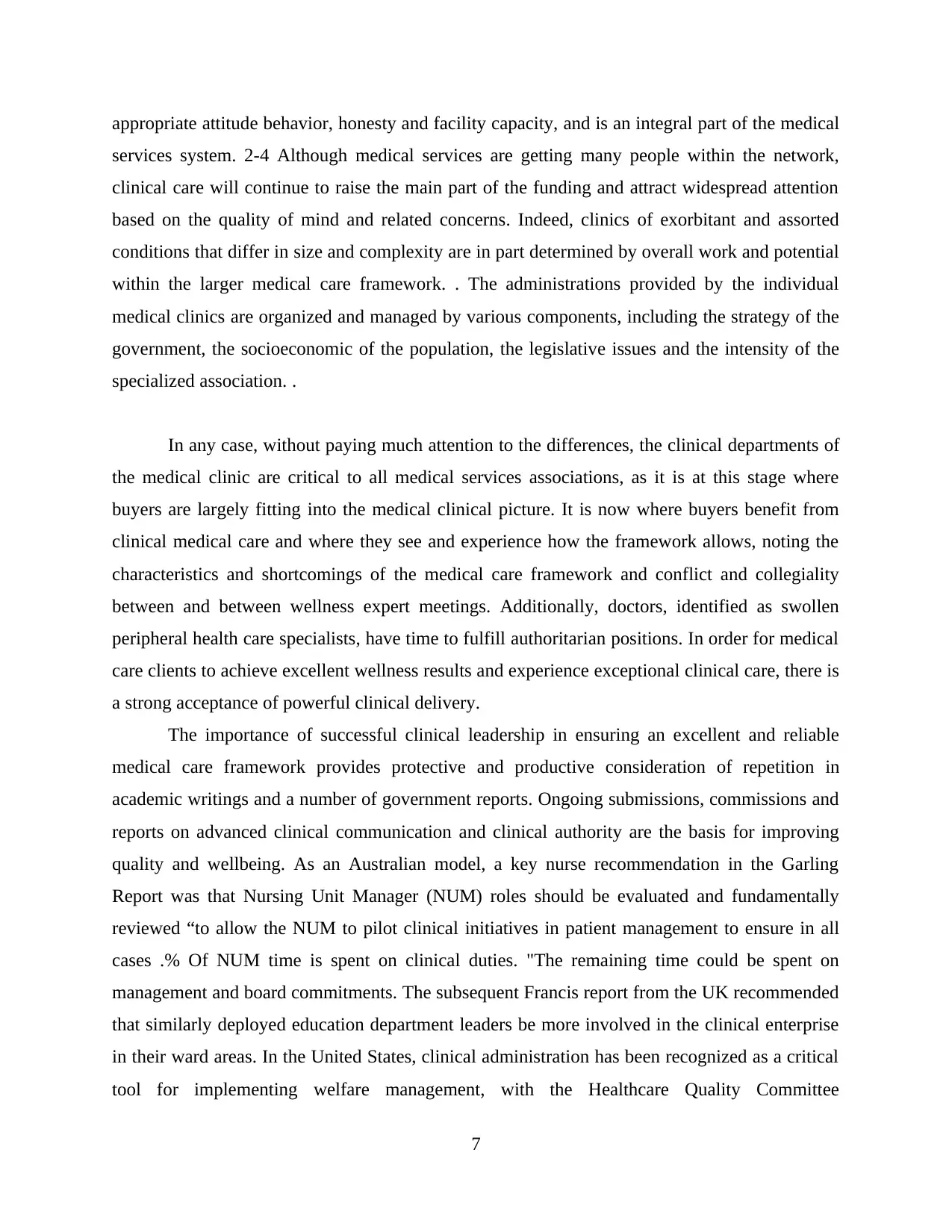
appropriate attitude behavior, honesty and facility capacity, and is an integral part of the medical
services system. 2-4 Although medical services are getting many people within the network,
clinical care will continue to raise the main part of the funding and attract widespread attention
based on the quality of mind and related concerns. Indeed, clinics of exorbitant and assorted
conditions that differ in size and complexity are in part determined by overall work and potential
within the larger medical care framework. . The administrations provided by the individual
medical clinics are organized and managed by various components, including the strategy of the
government, the socioeconomic of the population, the legislative issues and the intensity of the
specialized association. .
In any case, without paying much attention to the differences, the clinical departments of
the medical clinic are critical to all medical services associations, as it is at this stage where
buyers are largely fitting into the medical clinical picture. It is now where buyers benefit from
clinical medical care and where they see and experience how the framework allows, noting the
characteristics and shortcomings of the medical care framework and conflict and collegiality
between and between wellness expert meetings. Additionally, doctors, identified as swollen
peripheral health care specialists, have time to fulfill authoritarian positions. In order for medical
care clients to achieve excellent wellness results and experience exceptional clinical care, there is
a strong acceptance of powerful clinical delivery.
The importance of successful clinical leadership in ensuring an excellent and reliable
medical care framework provides protective and productive consideration of repetition in
academic writings and a number of government reports. Ongoing submissions, commissions and
reports on advanced clinical communication and clinical authority are the basis for improving
quality and wellbeing. As an Australian model, a key nurse recommendation in the Garling
Report was that Nursing Unit Manager (NUM) roles should be evaluated and fundamentally
reviewed “to allow the NUM to pilot clinical initiatives in patient management to ensure in all
cases .% Of NUM time is spent on clinical duties. "The remaining time could be spent on
management and board commitments. The subsequent Francis report from the UK recommended
that similarly deployed education department leaders be more involved in the clinical enterprise
in their ward areas. In the United States, clinical administration has been recognized as a critical
tool for implementing welfare management, with the Healthcare Quality Committee
7
services system. 2-4 Although medical services are getting many people within the network,
clinical care will continue to raise the main part of the funding and attract widespread attention
based on the quality of mind and related concerns. Indeed, clinics of exorbitant and assorted
conditions that differ in size and complexity are in part determined by overall work and potential
within the larger medical care framework. . The administrations provided by the individual
medical clinics are organized and managed by various components, including the strategy of the
government, the socioeconomic of the population, the legislative issues and the intensity of the
specialized association. .
In any case, without paying much attention to the differences, the clinical departments of
the medical clinic are critical to all medical services associations, as it is at this stage where
buyers are largely fitting into the medical clinical picture. It is now where buyers benefit from
clinical medical care and where they see and experience how the framework allows, noting the
characteristics and shortcomings of the medical care framework and conflict and collegiality
between and between wellness expert meetings. Additionally, doctors, identified as swollen
peripheral health care specialists, have time to fulfill authoritarian positions. In order for medical
care clients to achieve excellent wellness results and experience exceptional clinical care, there is
a strong acceptance of powerful clinical delivery.
The importance of successful clinical leadership in ensuring an excellent and reliable
medical care framework provides protective and productive consideration of repetition in
academic writings and a number of government reports. Ongoing submissions, commissions and
reports on advanced clinical communication and clinical authority are the basis for improving
quality and wellbeing. As an Australian model, a key nurse recommendation in the Garling
Report was that Nursing Unit Manager (NUM) roles should be evaluated and fundamentally
reviewed “to allow the NUM to pilot clinical initiatives in patient management to ensure in all
cases .% Of NUM time is spent on clinical duties. "The remaining time could be spent on
management and board commitments. The subsequent Francis report from the UK recommended
that similarly deployed education department leaders be more involved in the clinical enterprise
in their ward areas. In the United States, clinical administration has been recognized as a critical
tool for implementing welfare management, with the Healthcare Quality Committee
7
Secure Best Marks with AI Grader
Need help grading? Try our AI Grader for instant feedback on your assignments.
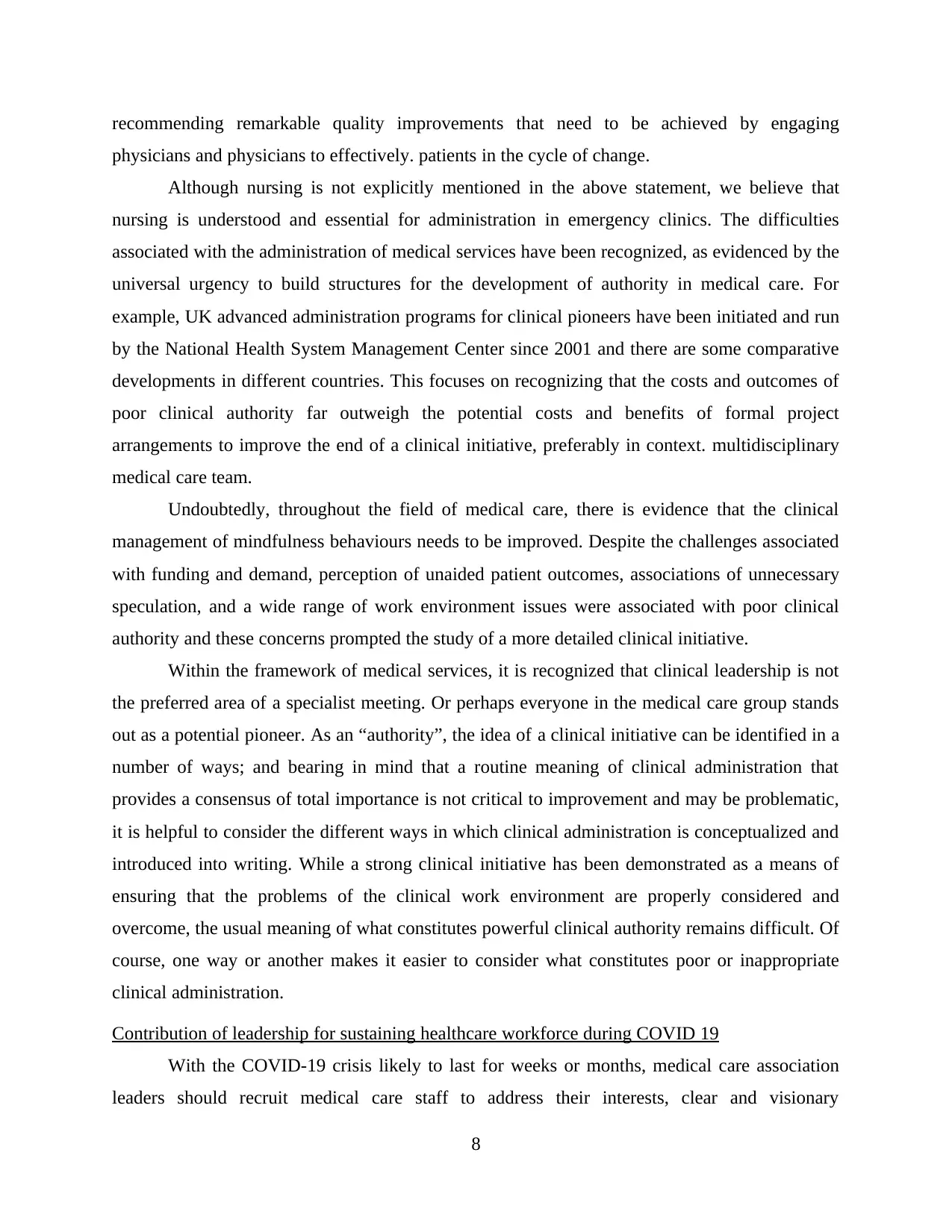
recommending remarkable quality improvements that need to be achieved by engaging
physicians and physicians to effectively. patients in the cycle of change.
Although nursing is not explicitly mentioned in the above statement, we believe that
nursing is understood and essential for administration in emergency clinics. The difficulties
associated with the administration of medical services have been recognized, as evidenced by the
universal urgency to build structures for the development of authority in medical care. For
example, UK advanced administration programs for clinical pioneers have been initiated and run
by the National Health System Management Center since 2001 and there are some comparative
developments in different countries. This focuses on recognizing that the costs and outcomes of
poor clinical authority far outweigh the potential costs and benefits of formal project
arrangements to improve the end of a clinical initiative, preferably in context. multidisciplinary
medical care team.
Undoubtedly, throughout the field of medical care, there is evidence that the clinical
management of mindfulness behaviours needs to be improved. Despite the challenges associated
with funding and demand, perception of unaided patient outcomes, associations of unnecessary
speculation, and a wide range of work environment issues were associated with poor clinical
authority and these concerns prompted the study of a more detailed clinical initiative.
Within the framework of medical services, it is recognized that clinical leadership is not
the preferred area of a specialist meeting. Or perhaps everyone in the medical care group stands
out as a potential pioneer. As an “authority”, the idea of a clinical initiative can be identified in a
number of ways; and bearing in mind that a routine meaning of clinical administration that
provides a consensus of total importance is not critical to improvement and may be problematic,
it is helpful to consider the different ways in which clinical administration is conceptualized and
introduced into writing. While a strong clinical initiative has been demonstrated as a means of
ensuring that the problems of the clinical work environment are properly considered and
overcome, the usual meaning of what constitutes powerful clinical authority remains difficult. Of
course, one way or another makes it easier to consider what constitutes poor or inappropriate
clinical administration.
Contribution of leadership for sustaining healthcare workforce during COVID 19
With the COVID-19 crisis likely to last for weeks or months, medical care association
leaders should recruit medical care staff to address their interests, clear and visionary
8
physicians and physicians to effectively. patients in the cycle of change.
Although nursing is not explicitly mentioned in the above statement, we believe that
nursing is understood and essential for administration in emergency clinics. The difficulties
associated with the administration of medical services have been recognized, as evidenced by the
universal urgency to build structures for the development of authority in medical care. For
example, UK advanced administration programs for clinical pioneers have been initiated and run
by the National Health System Management Center since 2001 and there are some comparative
developments in different countries. This focuses on recognizing that the costs and outcomes of
poor clinical authority far outweigh the potential costs and benefits of formal project
arrangements to improve the end of a clinical initiative, preferably in context. multidisciplinary
medical care team.
Undoubtedly, throughout the field of medical care, there is evidence that the clinical
management of mindfulness behaviours needs to be improved. Despite the challenges associated
with funding and demand, perception of unaided patient outcomes, associations of unnecessary
speculation, and a wide range of work environment issues were associated with poor clinical
authority and these concerns prompted the study of a more detailed clinical initiative.
Within the framework of medical services, it is recognized that clinical leadership is not
the preferred area of a specialist meeting. Or perhaps everyone in the medical care group stands
out as a potential pioneer. As an “authority”, the idea of a clinical initiative can be identified in a
number of ways; and bearing in mind that a routine meaning of clinical administration that
provides a consensus of total importance is not critical to improvement and may be problematic,
it is helpful to consider the different ways in which clinical administration is conceptualized and
introduced into writing. While a strong clinical initiative has been demonstrated as a means of
ensuring that the problems of the clinical work environment are properly considered and
overcome, the usual meaning of what constitutes powerful clinical authority remains difficult. Of
course, one way or another makes it easier to consider what constitutes poor or inappropriate
clinical administration.
Contribution of leadership for sustaining healthcare workforce during COVID 19
With the COVID-19 crisis likely to last for weeks or months, medical care association
leaders should recruit medical care staff to address their interests, clear and visionary
8
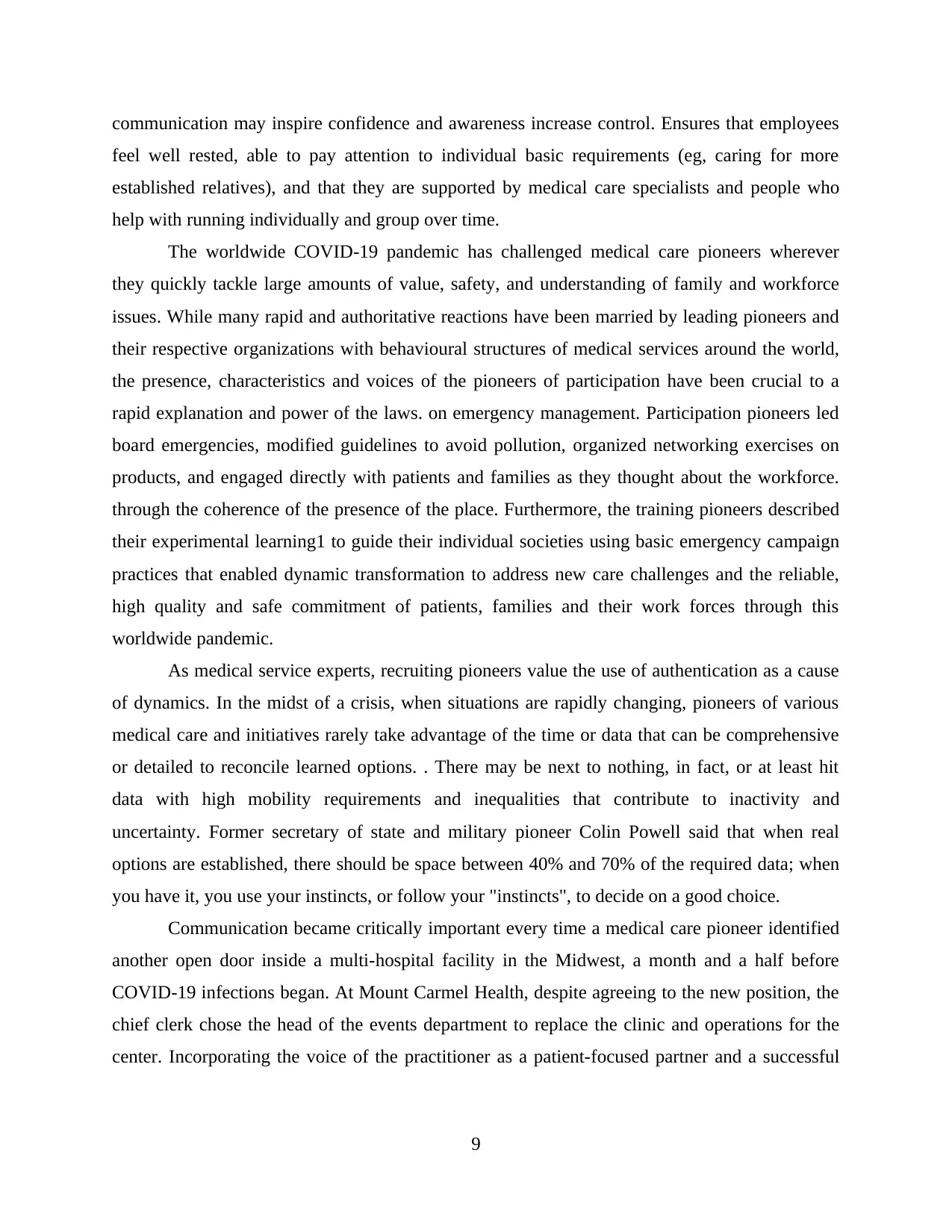
communication may inspire confidence and awareness increase control. Ensures that employees
feel well rested, able to pay attention to individual basic requirements (eg, caring for more
established relatives), and that they are supported by medical care specialists and people who
help with running individually and group over time.
The worldwide COVID-19 pandemic has challenged medical care pioneers wherever
they quickly tackle large amounts of value, safety, and understanding of family and workforce
issues. While many rapid and authoritative reactions have been married by leading pioneers and
their respective organizations with behavioural structures of medical services around the world,
the presence, characteristics and voices of the pioneers of participation have been crucial to a
rapid explanation and power of the laws. on emergency management. Participation pioneers led
board emergencies, modified guidelines to avoid pollution, organized networking exercises on
products, and engaged directly with patients and families as they thought about the workforce.
through the coherence of the presence of the place. Furthermore, the training pioneers described
their experimental learning1 to guide their individual societies using basic emergency campaign
practices that enabled dynamic transformation to address new care challenges and the reliable,
high quality and safe commitment of patients, families and their work forces through this
worldwide pandemic.
As medical service experts, recruiting pioneers value the use of authentication as a cause
of dynamics. In the midst of a crisis, when situations are rapidly changing, pioneers of various
medical care and initiatives rarely take advantage of the time or data that can be comprehensive
or detailed to reconcile learned options. . There may be next to nothing, in fact, or at least hit
data with high mobility requirements and inequalities that contribute to inactivity and
uncertainty. Former secretary of state and military pioneer Colin Powell said that when real
options are established, there should be space between 40% and 70% of the required data; when
you have it, you use your instincts, or follow your "instincts", to decide on a good choice.
Communication became critically important every time a medical care pioneer identified
another open door inside a multi-hospital facility in the Midwest, a month and a half before
COVID-19 infections began. At Mount Carmel Health, despite agreeing to the new position, the
chief clerk chose the head of the events department to replace the clinic and operations for the
center. Incorporating the voice of the practitioner as a patient-focused partner and a successful
9
feel well rested, able to pay attention to individual basic requirements (eg, caring for more
established relatives), and that they are supported by medical care specialists and people who
help with running individually and group over time.
The worldwide COVID-19 pandemic has challenged medical care pioneers wherever
they quickly tackle large amounts of value, safety, and understanding of family and workforce
issues. While many rapid and authoritative reactions have been married by leading pioneers and
their respective organizations with behavioural structures of medical services around the world,
the presence, characteristics and voices of the pioneers of participation have been crucial to a
rapid explanation and power of the laws. on emergency management. Participation pioneers led
board emergencies, modified guidelines to avoid pollution, organized networking exercises on
products, and engaged directly with patients and families as they thought about the workforce.
through the coherence of the presence of the place. Furthermore, the training pioneers described
their experimental learning1 to guide their individual societies using basic emergency campaign
practices that enabled dynamic transformation to address new care challenges and the reliable,
high quality and safe commitment of patients, families and their work forces through this
worldwide pandemic.
As medical service experts, recruiting pioneers value the use of authentication as a cause
of dynamics. In the midst of a crisis, when situations are rapidly changing, pioneers of various
medical care and initiatives rarely take advantage of the time or data that can be comprehensive
or detailed to reconcile learned options. . There may be next to nothing, in fact, or at least hit
data with high mobility requirements and inequalities that contribute to inactivity and
uncertainty. Former secretary of state and military pioneer Colin Powell said that when real
options are established, there should be space between 40% and 70% of the required data; when
you have it, you use your instincts, or follow your "instincts", to decide on a good choice.
Communication became critically important every time a medical care pioneer identified
another open door inside a multi-hospital facility in the Midwest, a month and a half before
COVID-19 infections began. At Mount Carmel Health, despite agreeing to the new position, the
chief clerk chose the head of the events department to replace the clinic and operations for the
center. Incorporating the voice of the practitioner as a patient-focused partner and a successful
9
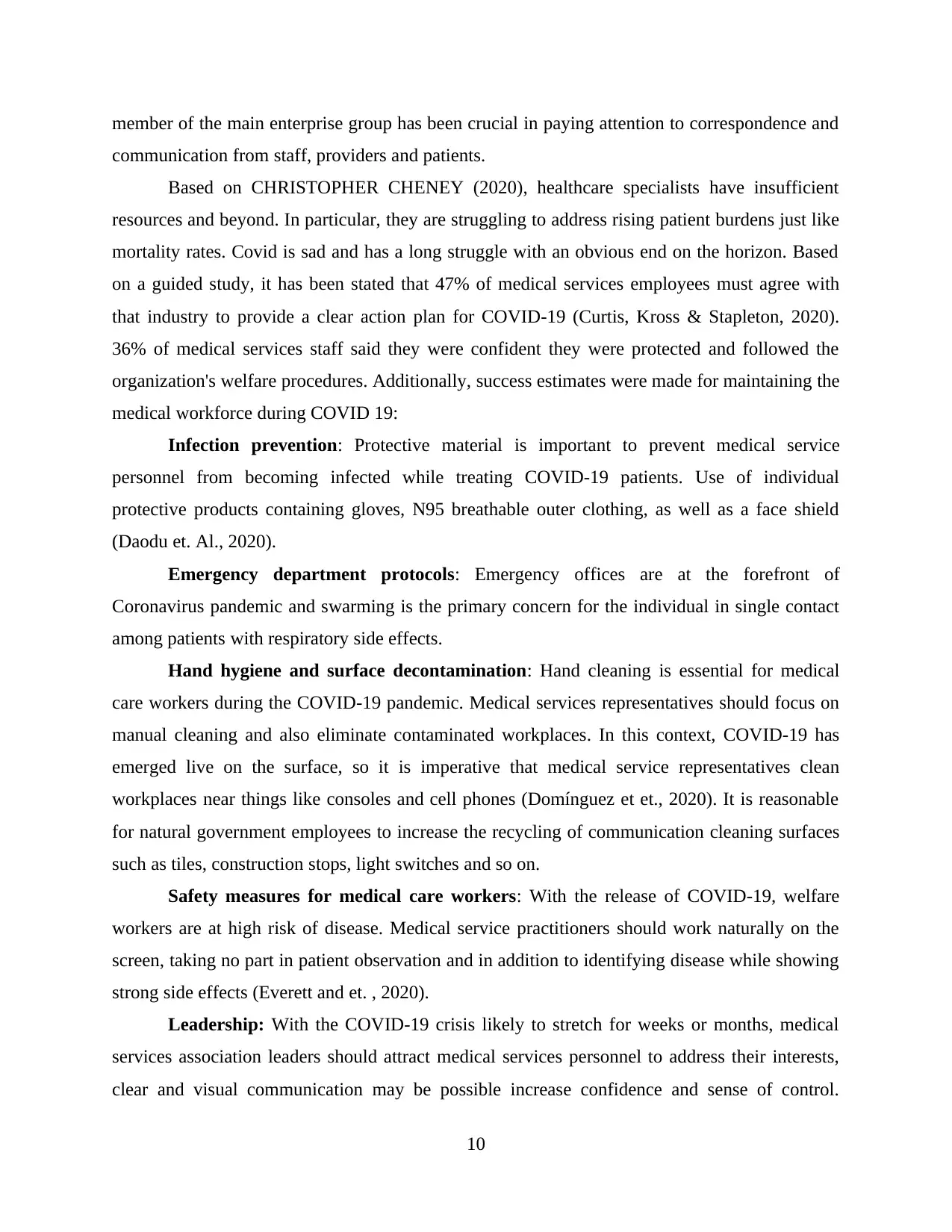
member of the main enterprise group has been crucial in paying attention to correspondence and
communication from staff, providers and patients.
Based on CHRISTOPHER CHENEY (2020), healthcare specialists have insufficient
resources and beyond. In particular, they are struggling to address rising patient burdens just like
mortality rates. Covid is sad and has a long struggle with an obvious end on the horizon. Based
on a guided study, it has been stated that 47% of medical services employees must agree with
that industry to provide a clear action plan for COVID-19 (Curtis, Kross & Stapleton, 2020).
36% of medical services staff said they were confident they were protected and followed the
organization's welfare procedures. Additionally, success estimates were made for maintaining the
medical workforce during COVID 19:
Infection prevention: Protective material is important to prevent medical service
personnel from becoming infected while treating COVID-19 patients. Use of individual
protective products containing gloves, N95 breathable outer clothing, as well as a face shield
(Daodu et. Al., 2020).
Emergency department protocols: Emergency offices are at the forefront of
Coronavirus pandemic and swarming is the primary concern for the individual in single contact
among patients with respiratory side effects.
Hand hygiene and surface decontamination: Hand cleaning is essential for medical
care workers during the COVID-19 pandemic. Medical services representatives should focus on
manual cleaning and also eliminate contaminated workplaces. In this context, COVID-19 has
emerged live on the surface, so it is imperative that medical service representatives clean
workplaces near things like consoles and cell phones (Domínguez et et., 2020). It is reasonable
for natural government employees to increase the recycling of communication cleaning surfaces
such as tiles, construction stops, light switches and so on.
Safety measures for medical care workers: With the release of COVID-19, welfare
workers are at high risk of disease. Medical service practitioners should work naturally on the
screen, taking no part in patient observation and in addition to identifying disease while showing
strong side effects (Everett and et. , 2020).
Leadership: With the COVID-19 crisis likely to stretch for weeks or months, medical
services association leaders should attract medical services personnel to address their interests,
clear and visual communication may be possible increase confidence and sense of control.
10
communication from staff, providers and patients.
Based on CHRISTOPHER CHENEY (2020), healthcare specialists have insufficient
resources and beyond. In particular, they are struggling to address rising patient burdens just like
mortality rates. Covid is sad and has a long struggle with an obvious end on the horizon. Based
on a guided study, it has been stated that 47% of medical services employees must agree with
that industry to provide a clear action plan for COVID-19 (Curtis, Kross & Stapleton, 2020).
36% of medical services staff said they were confident they were protected and followed the
organization's welfare procedures. Additionally, success estimates were made for maintaining the
medical workforce during COVID 19:
Infection prevention: Protective material is important to prevent medical service
personnel from becoming infected while treating COVID-19 patients. Use of individual
protective products containing gloves, N95 breathable outer clothing, as well as a face shield
(Daodu et. Al., 2020).
Emergency department protocols: Emergency offices are at the forefront of
Coronavirus pandemic and swarming is the primary concern for the individual in single contact
among patients with respiratory side effects.
Hand hygiene and surface decontamination: Hand cleaning is essential for medical
care workers during the COVID-19 pandemic. Medical services representatives should focus on
manual cleaning and also eliminate contaminated workplaces. In this context, COVID-19 has
emerged live on the surface, so it is imperative that medical service representatives clean
workplaces near things like consoles and cell phones (Domínguez et et., 2020). It is reasonable
for natural government employees to increase the recycling of communication cleaning surfaces
such as tiles, construction stops, light switches and so on.
Safety measures for medical care workers: With the release of COVID-19, welfare
workers are at high risk of disease. Medical service practitioners should work naturally on the
screen, taking no part in patient observation and in addition to identifying disease while showing
strong side effects (Everett and et. , 2020).
Leadership: With the COVID-19 crisis likely to stretch for weeks or months, medical
services association leaders should attract medical services personnel to address their interests,
clear and visual communication may be possible increase confidence and sense of control.
10
Paraphrase This Document
Need a fresh take? Get an instant paraphrase of this document with our AI Paraphraser
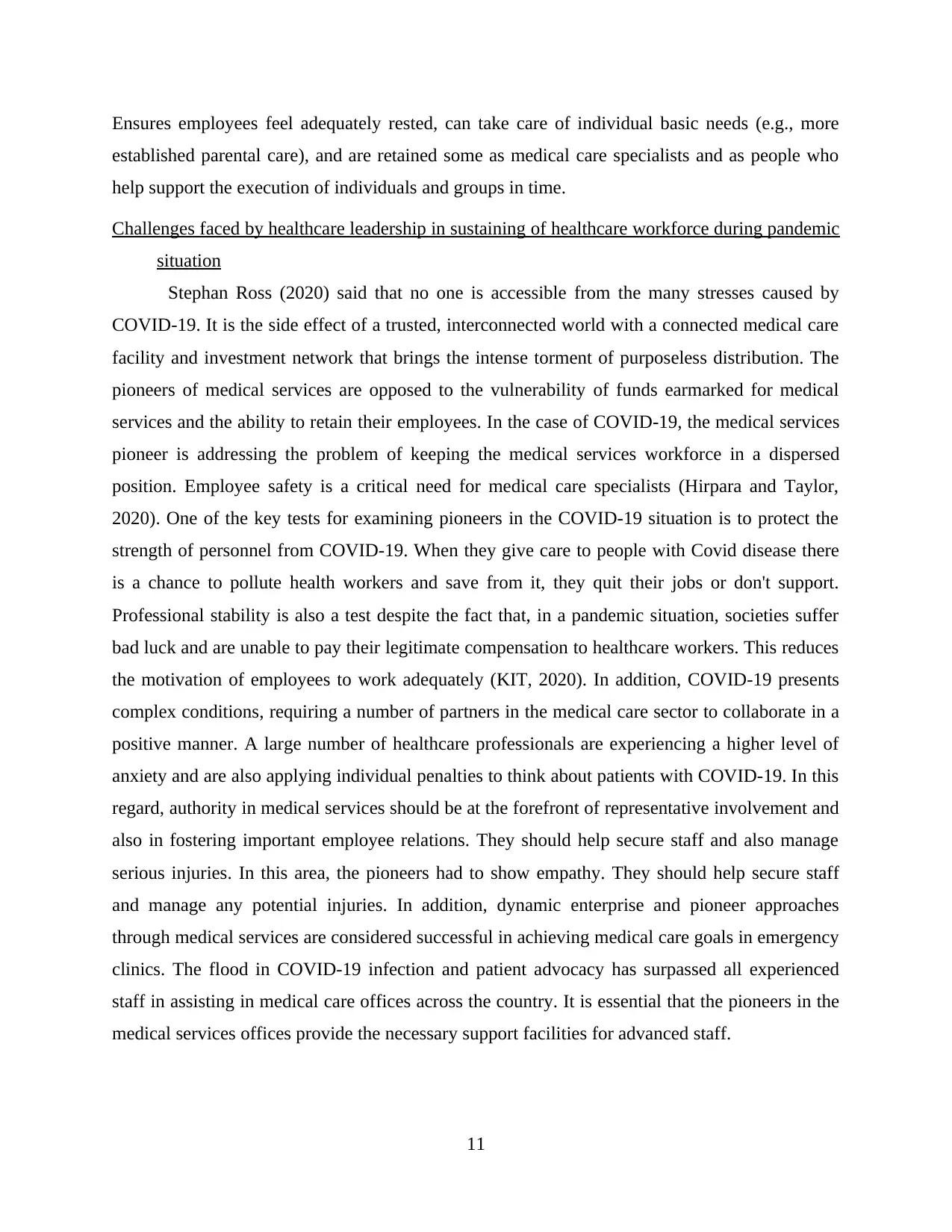
Ensures employees feel adequately rested, can take care of individual basic needs (e.g., more
established parental care), and are retained some as medical care specialists and as people who
help support the execution of individuals and groups in time.
Challenges faced by healthcare leadership in sustaining of healthcare workforce during pandemic
situation
Stephan Ross (2020) said that no one is accessible from the many stresses caused by
COVID-19. It is the side effect of a trusted, interconnected world with a connected medical care
facility and investment network that brings the intense torment of purposeless distribution. The
pioneers of medical services are opposed to the vulnerability of funds earmarked for medical
services and the ability to retain their employees. In the case of COVID-19, the medical services
pioneer is addressing the problem of keeping the medical services workforce in a dispersed
position. Employee safety is a critical need for medical care specialists (Hirpara and Taylor,
2020). One of the key tests for examining pioneers in the COVID-19 situation is to protect the
strength of personnel from COVID-19. When they give care to people with Covid disease there
is a chance to pollute health workers and save from it, they quit their jobs or don't support.
Professional stability is also a test despite the fact that, in a pandemic situation, societies suffer
bad luck and are unable to pay their legitimate compensation to healthcare workers. This reduces
the motivation of employees to work adequately (KIT, 2020). In addition, COVID-19 presents
complex conditions, requiring a number of partners in the medical care sector to collaborate in a
positive manner. A large number of healthcare professionals are experiencing a higher level of
anxiety and are also applying individual penalties to think about patients with COVID-19. In this
regard, authority in medical services should be at the forefront of representative involvement and
also in fostering important employee relations. They should help secure staff and also manage
serious injuries. In this area, the pioneers had to show empathy. They should help secure staff
and manage any potential injuries. In addition, dynamic enterprise and pioneer approaches
through medical services are considered successful in achieving medical care goals in emergency
clinics. The flood in COVID-19 infection and patient advocacy has surpassed all experienced
staff in assisting in medical care offices across the country. It is essential that the pioneers in the
medical services offices provide the necessary support facilities for advanced staff.
11
established parental care), and are retained some as medical care specialists and as people who
help support the execution of individuals and groups in time.
Challenges faced by healthcare leadership in sustaining of healthcare workforce during pandemic
situation
Stephan Ross (2020) said that no one is accessible from the many stresses caused by
COVID-19. It is the side effect of a trusted, interconnected world with a connected medical care
facility and investment network that brings the intense torment of purposeless distribution. The
pioneers of medical services are opposed to the vulnerability of funds earmarked for medical
services and the ability to retain their employees. In the case of COVID-19, the medical services
pioneer is addressing the problem of keeping the medical services workforce in a dispersed
position. Employee safety is a critical need for medical care specialists (Hirpara and Taylor,
2020). One of the key tests for examining pioneers in the COVID-19 situation is to protect the
strength of personnel from COVID-19. When they give care to people with Covid disease there
is a chance to pollute health workers and save from it, they quit their jobs or don't support.
Professional stability is also a test despite the fact that, in a pandemic situation, societies suffer
bad luck and are unable to pay their legitimate compensation to healthcare workers. This reduces
the motivation of employees to work adequately (KIT, 2020). In addition, COVID-19 presents
complex conditions, requiring a number of partners in the medical care sector to collaborate in a
positive manner. A large number of healthcare professionals are experiencing a higher level of
anxiety and are also applying individual penalties to think about patients with COVID-19. In this
regard, authority in medical services should be at the forefront of representative involvement and
also in fostering important employee relations. They should help secure staff and also manage
serious injuries. In this area, the pioneers had to show empathy. They should help secure staff
and manage any potential injuries. In addition, dynamic enterprise and pioneer approaches
through medical services are considered successful in achieving medical care goals in emergency
clinics. The flood in COVID-19 infection and patient advocacy has surpassed all experienced
staff in assisting in medical care offices across the country. It is essential that the pioneers in the
medical services offices provide the necessary support facilities for advanced staff.
11
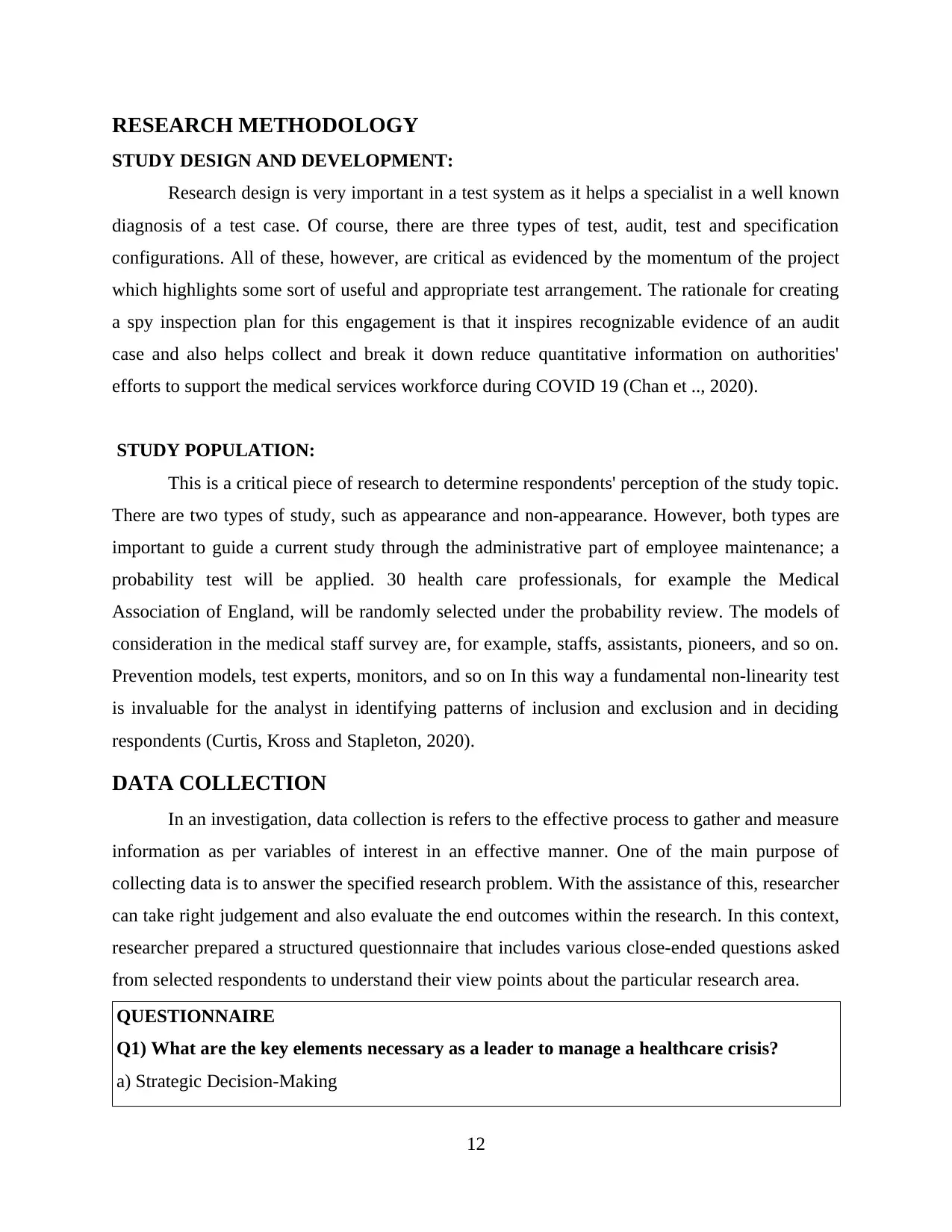
RESEARCH METHODOLOGY
STUDY DESIGN AND DEVELOPMENT:
Research design is very important in a test system as it helps a specialist in a well known
diagnosis of a test case. Of course, there are three types of test, audit, test and specification
configurations. All of these, however, are critical as evidenced by the momentum of the project
which highlights some sort of useful and appropriate test arrangement. The rationale for creating
a spy inspection plan for this engagement is that it inspires recognizable evidence of an audit
case and also helps collect and break it down reduce quantitative information on authorities'
efforts to support the medical services workforce during COVID 19 (Chan et .., 2020).
STUDY POPULATION:
This is a critical piece of research to determine respondents' perception of the study topic.
There are two types of study, such as appearance and non-appearance. However, both types are
important to guide a current study through the administrative part of employee maintenance; a
probability test will be applied. 30 health care professionals, for example the Medical
Association of England, will be randomly selected under the probability review. The models of
consideration in the medical staff survey are, for example, staffs, assistants, pioneers, and so on.
Prevention models, test experts, monitors, and so on In this way a fundamental non-linearity test
is invaluable for the analyst in identifying patterns of inclusion and exclusion and in deciding
respondents (Curtis, Kross and Stapleton, 2020).
DATA COLLECTION
In an investigation, data collection is refers to the effective process to gather and measure
information as per variables of interest in an effective manner. One of the main purpose of
collecting data is to answer the specified research problem. With the assistance of this, researcher
can take right judgement and also evaluate the end outcomes within the research. In this context,
researcher prepared a structured questionnaire that includes various close-ended questions asked
from selected respondents to understand their view points about the particular research area.
QUESTIONNAIRE
Q1) What are the key elements necessary as a leader to manage a healthcare crisis?
a) Strategic Decision-Making
12
STUDY DESIGN AND DEVELOPMENT:
Research design is very important in a test system as it helps a specialist in a well known
diagnosis of a test case. Of course, there are three types of test, audit, test and specification
configurations. All of these, however, are critical as evidenced by the momentum of the project
which highlights some sort of useful and appropriate test arrangement. The rationale for creating
a spy inspection plan for this engagement is that it inspires recognizable evidence of an audit
case and also helps collect and break it down reduce quantitative information on authorities'
efforts to support the medical services workforce during COVID 19 (Chan et .., 2020).
STUDY POPULATION:
This is a critical piece of research to determine respondents' perception of the study topic.
There are two types of study, such as appearance and non-appearance. However, both types are
important to guide a current study through the administrative part of employee maintenance; a
probability test will be applied. 30 health care professionals, for example the Medical
Association of England, will be randomly selected under the probability review. The models of
consideration in the medical staff survey are, for example, staffs, assistants, pioneers, and so on.
Prevention models, test experts, monitors, and so on In this way a fundamental non-linearity test
is invaluable for the analyst in identifying patterns of inclusion and exclusion and in deciding
respondents (Curtis, Kross and Stapleton, 2020).
DATA COLLECTION
In an investigation, data collection is refers to the effective process to gather and measure
information as per variables of interest in an effective manner. One of the main purpose of
collecting data is to answer the specified research problem. With the assistance of this, researcher
can take right judgement and also evaluate the end outcomes within the research. In this context,
researcher prepared a structured questionnaire that includes various close-ended questions asked
from selected respondents to understand their view points about the particular research area.
QUESTIONNAIRE
Q1) What are the key elements necessary as a leader to manage a healthcare crisis?
a) Strategic Decision-Making
12
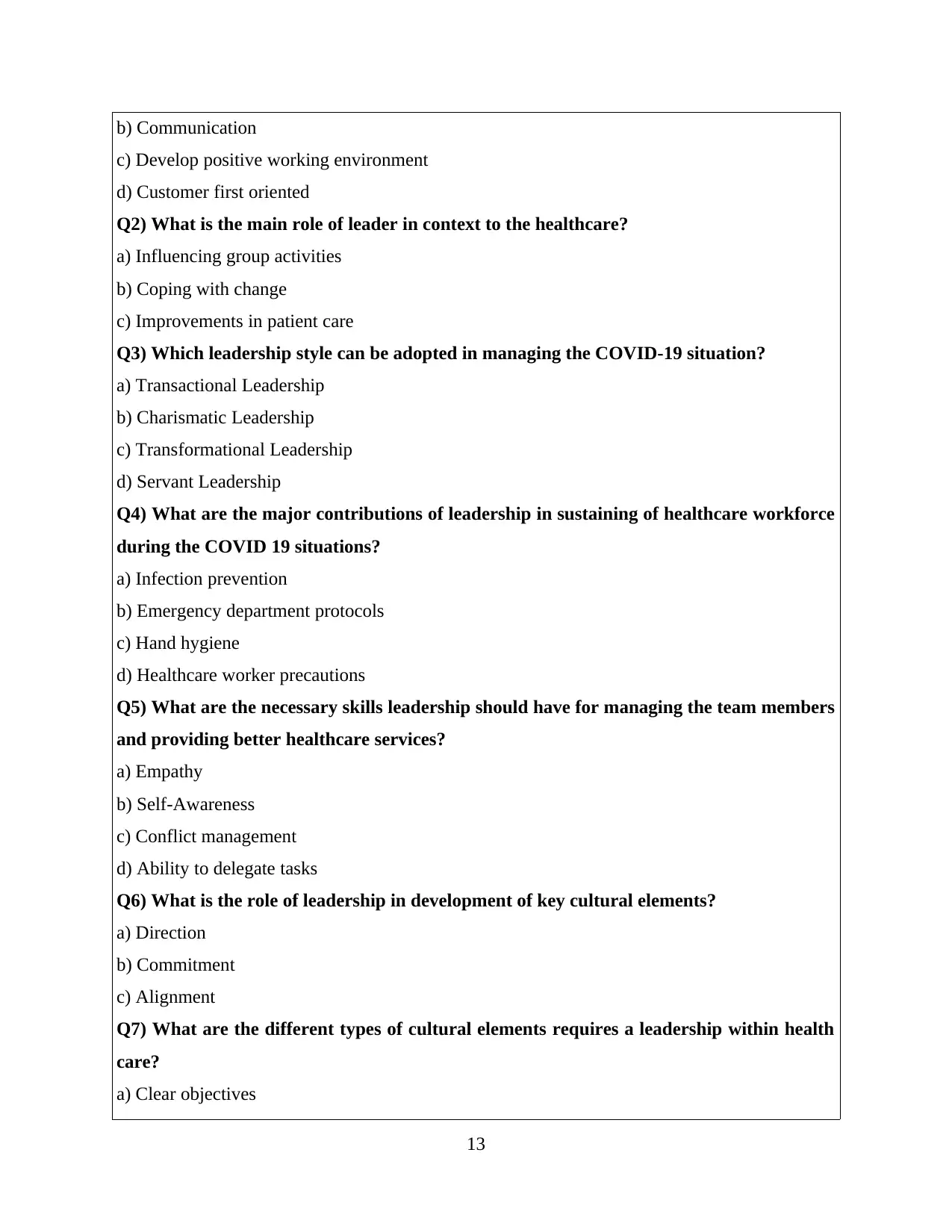
b) Communication
c) Develop positive working environment
d) Customer first oriented
Q2) What is the main role of leader in context to the healthcare?
a) Influencing group activities
b) Coping with change
c) Improvements in patient care
Q3) Which leadership style can be adopted in managing the COVID-19 situation?
a) Transactional Leadership
b) Charismatic Leadership
c) Transformational Leadership
d) Servant Leadership
Q4) What are the major contributions of leadership in sustaining of healthcare workforce
during the COVID 19 situations?
a) Infection prevention
b) Emergency department protocols
c) Hand hygiene
d) Healthcare worker precautions
Q5) What are the necessary skills leadership should have for managing the team members
and providing better healthcare services?
a) Empathy
b) Self-Awareness
c) Conflict management
d) Ability to delegate tasks
Q6) What is the role of leadership in development of key cultural elements?
a) Direction
b) Commitment
c) Alignment
Q7) What are the different types of cultural elements requires a leadership within health
care?
a) Clear objectives
13
c) Develop positive working environment
d) Customer first oriented
Q2) What is the main role of leader in context to the healthcare?
a) Influencing group activities
b) Coping with change
c) Improvements in patient care
Q3) Which leadership style can be adopted in managing the COVID-19 situation?
a) Transactional Leadership
b) Charismatic Leadership
c) Transformational Leadership
d) Servant Leadership
Q4) What are the major contributions of leadership in sustaining of healthcare workforce
during the COVID 19 situations?
a) Infection prevention
b) Emergency department protocols
c) Hand hygiene
d) Healthcare worker precautions
Q5) What are the necessary skills leadership should have for managing the team members
and providing better healthcare services?
a) Empathy
b) Self-Awareness
c) Conflict management
d) Ability to delegate tasks
Q6) What is the role of leadership in development of key cultural elements?
a) Direction
b) Commitment
c) Alignment
Q7) What are the different types of cultural elements requires a leadership within health
care?
a) Clear objectives
13
Secure Best Marks with AI Grader
Need help grading? Try our AI Grader for instant feedback on your assignments.
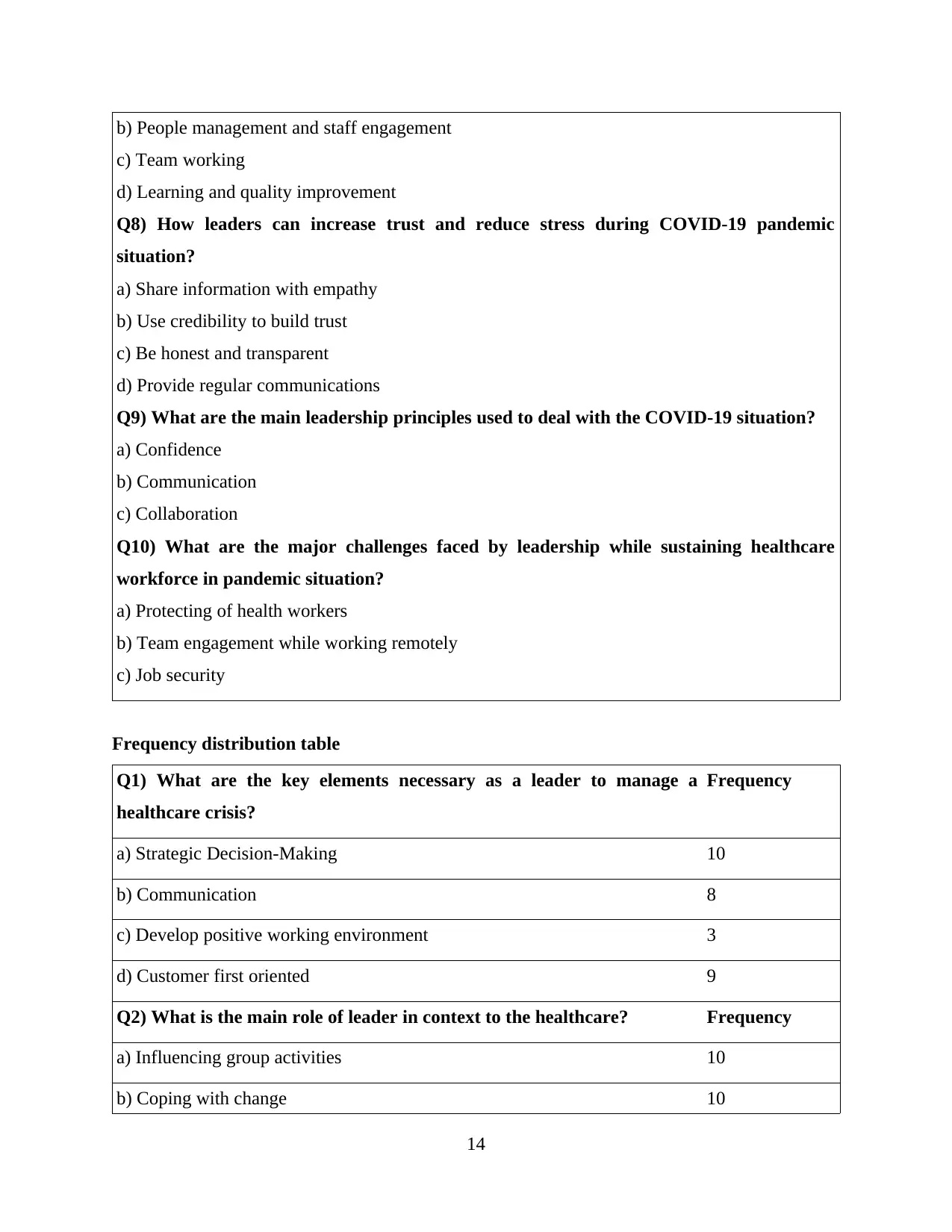
b) People management and staff engagement
c) Team working
d) Learning and quality improvement
Q8) How leaders can increase trust and reduce stress during COVID-19 pandemic
situation?
a) Share information with empathy
b) Use credibility to build trust
c) Be honest and transparent
d) Provide regular communications
Q9) What are the main leadership principles used to deal with the COVID-19 situation?
a) Confidence
b) Communication
c) Collaboration
Q10) What are the major challenges faced by leadership while sustaining healthcare
workforce in pandemic situation?
a) Protecting of health workers
b) Team engagement while working remotely
c) Job security
Frequency distribution table
Q1) What are the key elements necessary as a leader to manage a
healthcare crisis?
Frequency
a) Strategic Decision-Making 10
b) Communication 8
c) Develop positive working environment 3
d) Customer first oriented 9
Q2) What is the main role of leader in context to the healthcare? Frequency
a) Influencing group activities 10
b) Coping with change 10
14
c) Team working
d) Learning and quality improvement
Q8) How leaders can increase trust and reduce stress during COVID-19 pandemic
situation?
a) Share information with empathy
b) Use credibility to build trust
c) Be honest and transparent
d) Provide regular communications
Q9) What are the main leadership principles used to deal with the COVID-19 situation?
a) Confidence
b) Communication
c) Collaboration
Q10) What are the major challenges faced by leadership while sustaining healthcare
workforce in pandemic situation?
a) Protecting of health workers
b) Team engagement while working remotely
c) Job security
Frequency distribution table
Q1) What are the key elements necessary as a leader to manage a
healthcare crisis?
Frequency
a) Strategic Decision-Making 10
b) Communication 8
c) Develop positive working environment 3
d) Customer first oriented 9
Q2) What is the main role of leader in context to the healthcare? Frequency
a) Influencing group activities 10
b) Coping with change 10
14
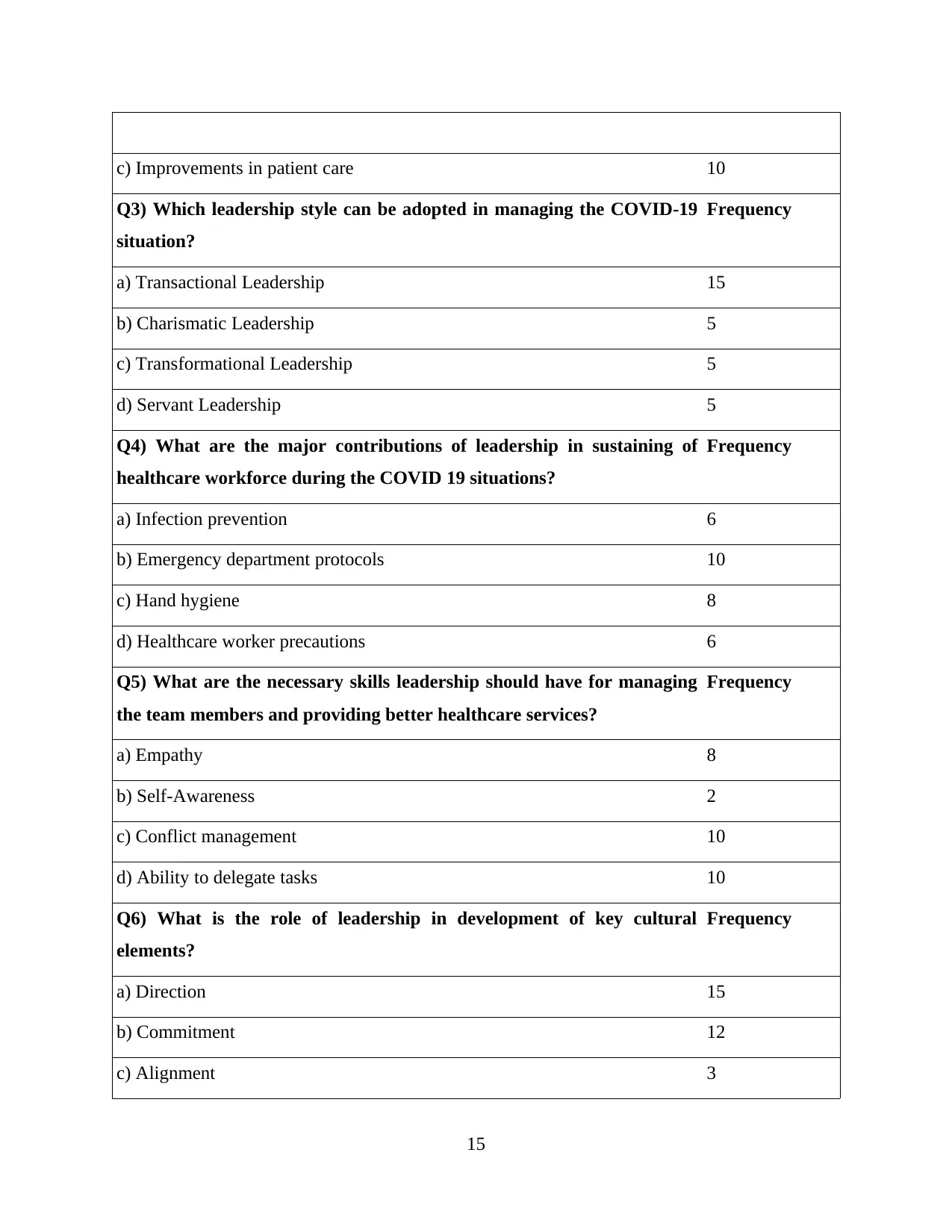
c) Improvements in patient care 10
Q3) Which leadership style can be adopted in managing the COVID-19
situation?
Frequency
a) Transactional Leadership 15
b) Charismatic Leadership 5
c) Transformational Leadership 5
d) Servant Leadership 5
Q4) What are the major contributions of leadership in sustaining of
healthcare workforce during the COVID 19 situations?
Frequency
a) Infection prevention 6
b) Emergency department protocols 10
c) Hand hygiene 8
d) Healthcare worker precautions 6
Q5) What are the necessary skills leadership should have for managing
the team members and providing better healthcare services?
Frequency
a) Empathy 8
b) Self-Awareness 2
c) Conflict management 10
d) Ability to delegate tasks 10
Q6) What is the role of leadership in development of key cultural
elements?
Frequency
a) Direction 15
b) Commitment 12
c) Alignment 3
15
Q3) Which leadership style can be adopted in managing the COVID-19
situation?
Frequency
a) Transactional Leadership 15
b) Charismatic Leadership 5
c) Transformational Leadership 5
d) Servant Leadership 5
Q4) What are the major contributions of leadership in sustaining of
healthcare workforce during the COVID 19 situations?
Frequency
a) Infection prevention 6
b) Emergency department protocols 10
c) Hand hygiene 8
d) Healthcare worker precautions 6
Q5) What are the necessary skills leadership should have for managing
the team members and providing better healthcare services?
Frequency
a) Empathy 8
b) Self-Awareness 2
c) Conflict management 10
d) Ability to delegate tasks 10
Q6) What is the role of leadership in development of key cultural
elements?
Frequency
a) Direction 15
b) Commitment 12
c) Alignment 3
15
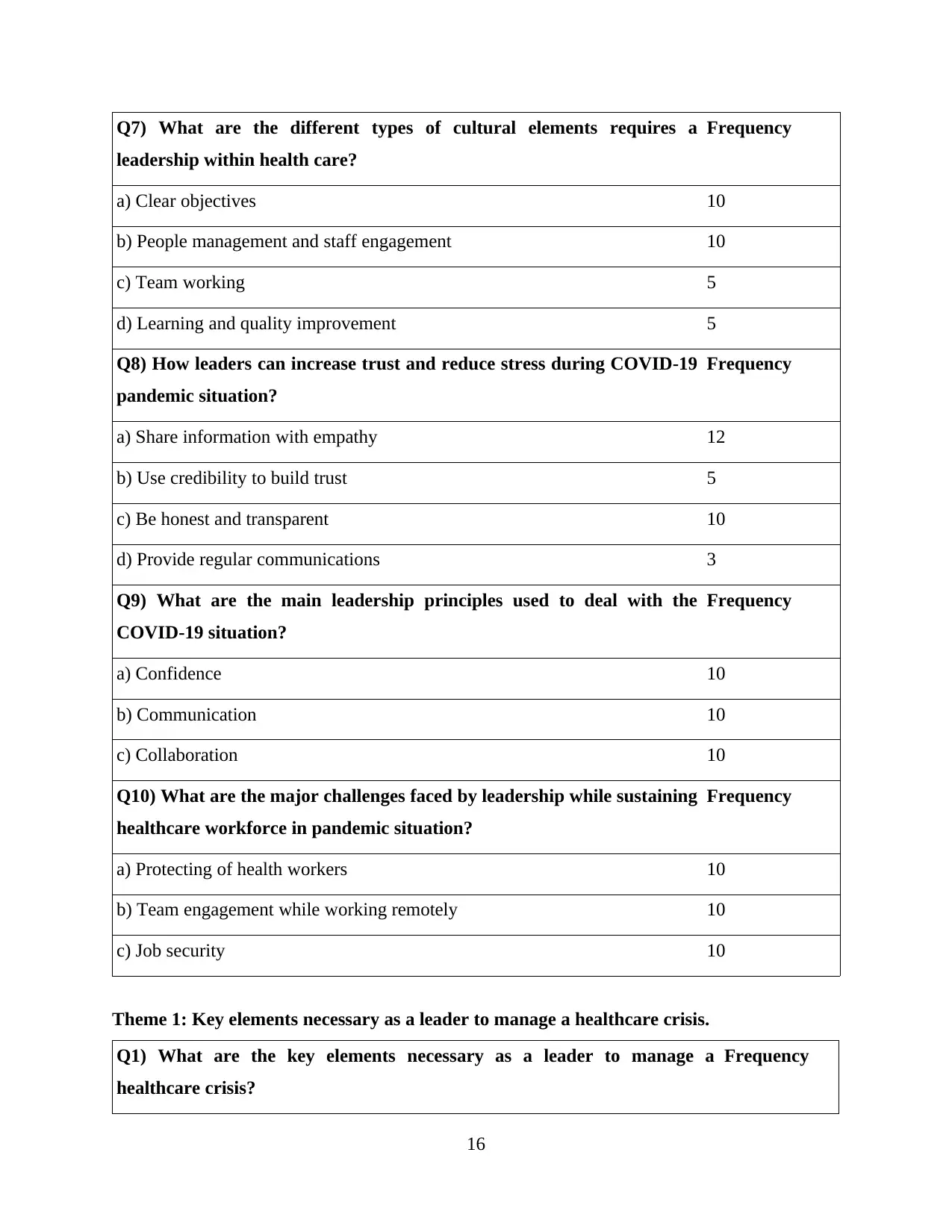
Q7) What are the different types of cultural elements requires a
leadership within health care?
Frequency
a) Clear objectives 10
b) People management and staff engagement 10
c) Team working 5
d) Learning and quality improvement 5
Q8) How leaders can increase trust and reduce stress during COVID-19
pandemic situation?
Frequency
a) Share information with empathy 12
b) Use credibility to build trust 5
c) Be honest and transparent 10
d) Provide regular communications 3
Q9) What are the main leadership principles used to deal with the
COVID-19 situation?
Frequency
a) Confidence 10
b) Communication 10
c) Collaboration 10
Q10) What are the major challenges faced by leadership while sustaining
healthcare workforce in pandemic situation?
Frequency
a) Protecting of health workers 10
b) Team engagement while working remotely 10
c) Job security 10
Theme 1: Key elements necessary as a leader to manage a healthcare crisis.
Q1) What are the key elements necessary as a leader to manage a
healthcare crisis?
Frequency
16
leadership within health care?
Frequency
a) Clear objectives 10
b) People management and staff engagement 10
c) Team working 5
d) Learning and quality improvement 5
Q8) How leaders can increase trust and reduce stress during COVID-19
pandemic situation?
Frequency
a) Share information with empathy 12
b) Use credibility to build trust 5
c) Be honest and transparent 10
d) Provide regular communications 3
Q9) What are the main leadership principles used to deal with the
COVID-19 situation?
Frequency
a) Confidence 10
b) Communication 10
c) Collaboration 10
Q10) What are the major challenges faced by leadership while sustaining
healthcare workforce in pandemic situation?
Frequency
a) Protecting of health workers 10
b) Team engagement while working remotely 10
c) Job security 10
Theme 1: Key elements necessary as a leader to manage a healthcare crisis.
Q1) What are the key elements necessary as a leader to manage a
healthcare crisis?
Frequency
16
Paraphrase This Document
Need a fresh take? Get an instant paraphrase of this document with our AI Paraphraser
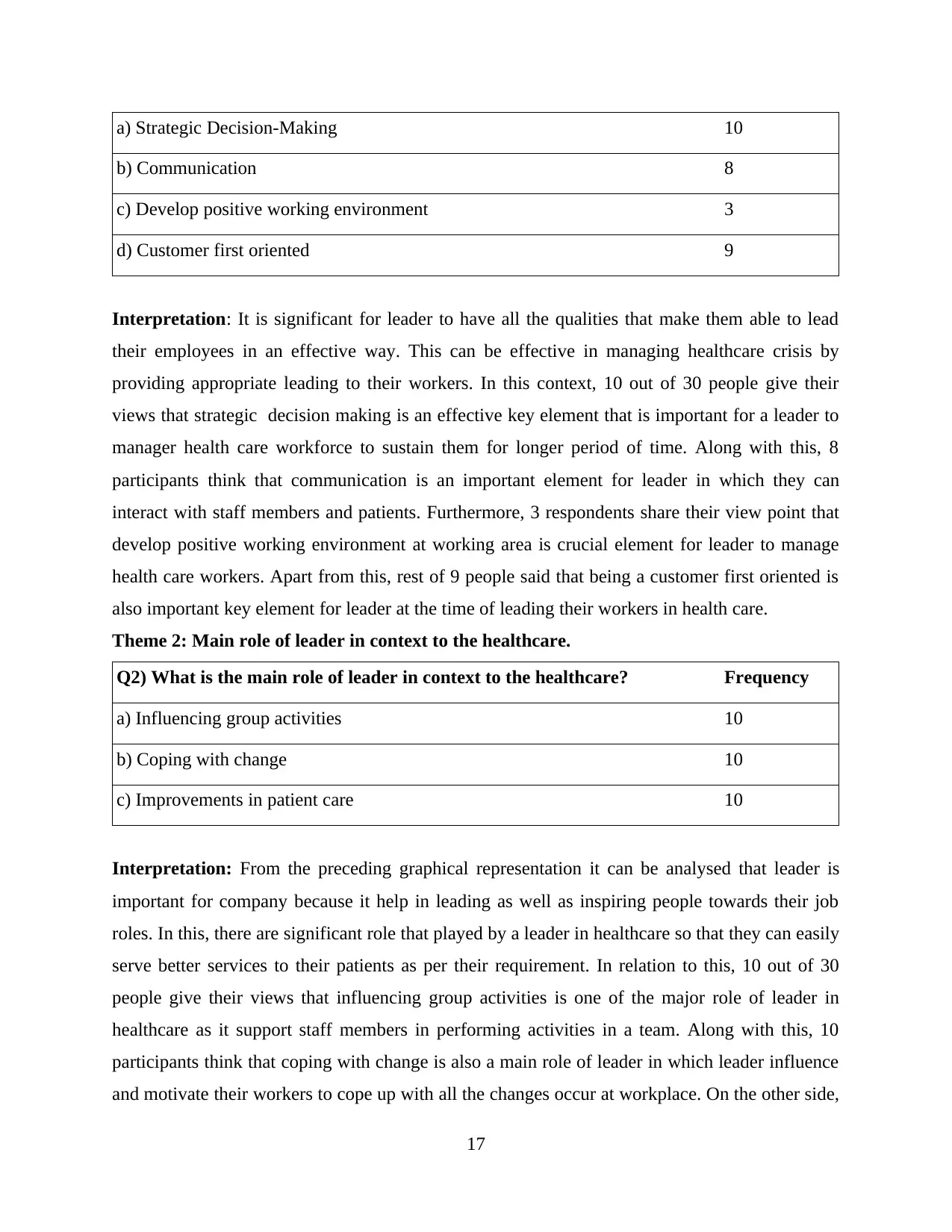
a) Strategic Decision-Making 10
b) Communication 8
c) Develop positive working environment 3
d) Customer first oriented 9
Interpretation: It is significant for leader to have all the qualities that make them able to lead
their employees in an effective way. This can be effective in managing healthcare crisis by
providing appropriate leading to their workers. In this context, 10 out of 30 people give their
views that strategic decision making is an effective key element that is important for a leader to
manager health care workforce to sustain them for longer period of time. Along with this, 8
participants think that communication is an important element for leader in which they can
interact with staff members and patients. Furthermore, 3 respondents share their view point that
develop positive working environment at working area is crucial element for leader to manage
health care workers. Apart from this, rest of 9 people said that being a customer first oriented is
also important key element for leader at the time of leading their workers in health care.
Theme 2: Main role of leader in context to the healthcare.
Q2) What is the main role of leader in context to the healthcare? Frequency
a) Influencing group activities 10
b) Coping with change 10
c) Improvements in patient care 10
Interpretation: From the preceding graphical representation it can be analysed that leader is
important for company because it help in leading as well as inspiring people towards their job
roles. In this, there are significant role that played by a leader in healthcare so that they can easily
serve better services to their patients as per their requirement. In relation to this, 10 out of 30
people give their views that influencing group activities is one of the major role of leader in
healthcare as it support staff members in performing activities in a team. Along with this, 10
participants think that coping with change is also a main role of leader in which leader influence
and motivate their workers to cope up with all the changes occur at workplace. On the other side,
17
b) Communication 8
c) Develop positive working environment 3
d) Customer first oriented 9
Interpretation: It is significant for leader to have all the qualities that make them able to lead
their employees in an effective way. This can be effective in managing healthcare crisis by
providing appropriate leading to their workers. In this context, 10 out of 30 people give their
views that strategic decision making is an effective key element that is important for a leader to
manager health care workforce to sustain them for longer period of time. Along with this, 8
participants think that communication is an important element for leader in which they can
interact with staff members and patients. Furthermore, 3 respondents share their view point that
develop positive working environment at working area is crucial element for leader to manage
health care workers. Apart from this, rest of 9 people said that being a customer first oriented is
also important key element for leader at the time of leading their workers in health care.
Theme 2: Main role of leader in context to the healthcare.
Q2) What is the main role of leader in context to the healthcare? Frequency
a) Influencing group activities 10
b) Coping with change 10
c) Improvements in patient care 10
Interpretation: From the preceding graphical representation it can be analysed that leader is
important for company because it help in leading as well as inspiring people towards their job
roles. In this, there are significant role that played by a leader in healthcare so that they can easily
serve better services to their patients as per their requirement. In relation to this, 10 out of 30
people give their views that influencing group activities is one of the major role of leader in
healthcare as it support staff members in performing activities in a team. Along with this, 10
participants think that coping with change is also a main role of leader in which leader influence
and motivate their workers to cope up with all the changes occur at workplace. On the other side,
17
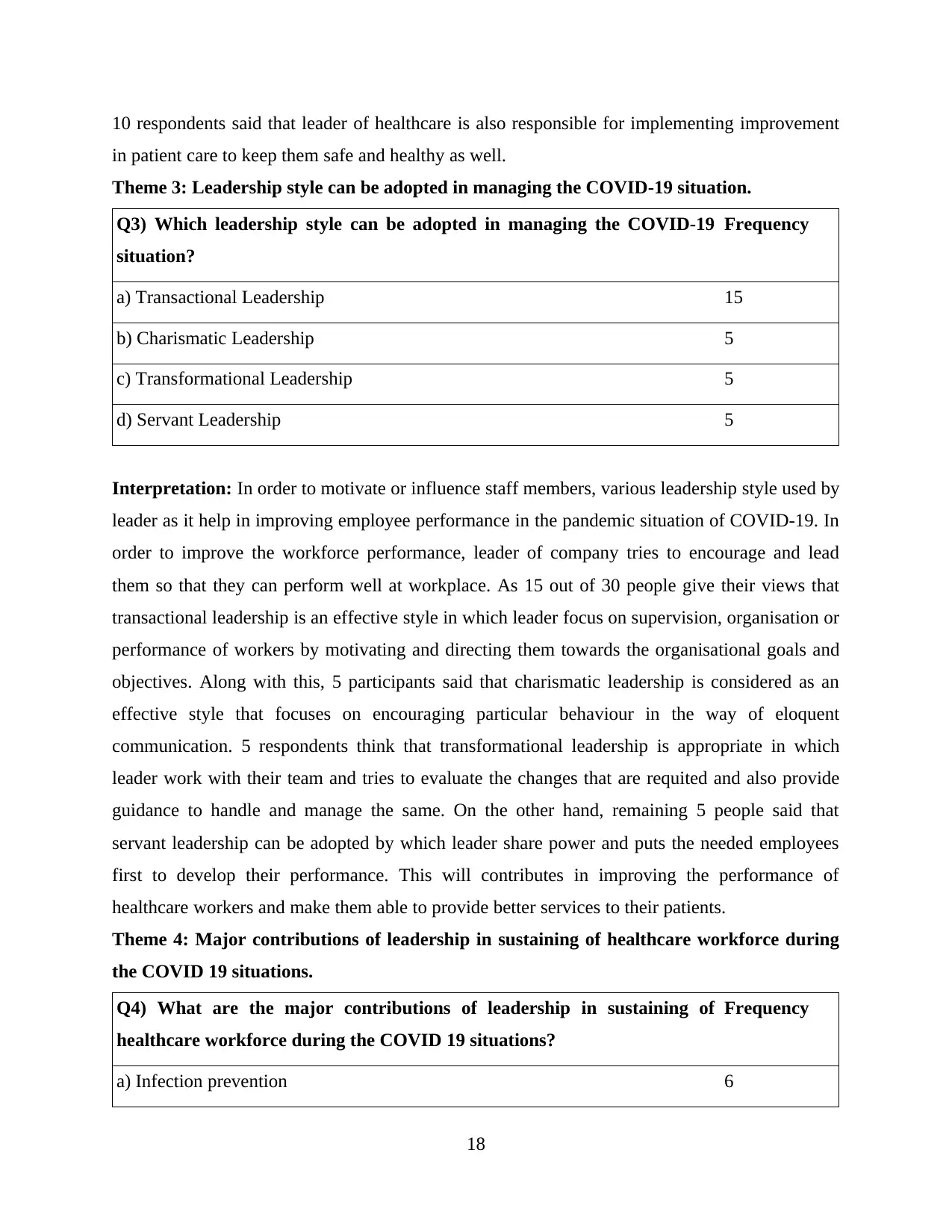
10 respondents said that leader of healthcare is also responsible for implementing improvement
in patient care to keep them safe and healthy as well.
Theme 3: Leadership style can be adopted in managing the COVID-19 situation.
Q3) Which leadership style can be adopted in managing the COVID-19
situation?
Frequency
a) Transactional Leadership 15
b) Charismatic Leadership 5
c) Transformational Leadership 5
d) Servant Leadership 5
Interpretation: In order to motivate or influence staff members, various leadership style used by
leader as it help in improving employee performance in the pandemic situation of COVID-19. In
order to improve the workforce performance, leader of company tries to encourage and lead
them so that they can perform well at workplace. As 15 out of 30 people give their views that
transactional leadership is an effective style in which leader focus on supervision, organisation or
performance of workers by motivating and directing them towards the organisational goals and
objectives. Along with this, 5 participants said that charismatic leadership is considered as an
effective style that focuses on encouraging particular behaviour in the way of eloquent
communication. 5 respondents think that transformational leadership is appropriate in which
leader work with their team and tries to evaluate the changes that are requited and also provide
guidance to handle and manage the same. On the other hand, remaining 5 people said that
servant leadership can be adopted by which leader share power and puts the needed employees
first to develop their performance. This will contributes in improving the performance of
healthcare workers and make them able to provide better services to their patients.
Theme 4: Major contributions of leadership in sustaining of healthcare workforce during
the COVID 19 situations.
Q4) What are the major contributions of leadership in sustaining of
healthcare workforce during the COVID 19 situations?
Frequency
a) Infection prevention 6
18
in patient care to keep them safe and healthy as well.
Theme 3: Leadership style can be adopted in managing the COVID-19 situation.
Q3) Which leadership style can be adopted in managing the COVID-19
situation?
Frequency
a) Transactional Leadership 15
b) Charismatic Leadership 5
c) Transformational Leadership 5
d) Servant Leadership 5
Interpretation: In order to motivate or influence staff members, various leadership style used by
leader as it help in improving employee performance in the pandemic situation of COVID-19. In
order to improve the workforce performance, leader of company tries to encourage and lead
them so that they can perform well at workplace. As 15 out of 30 people give their views that
transactional leadership is an effective style in which leader focus on supervision, organisation or
performance of workers by motivating and directing them towards the organisational goals and
objectives. Along with this, 5 participants said that charismatic leadership is considered as an
effective style that focuses on encouraging particular behaviour in the way of eloquent
communication. 5 respondents think that transformational leadership is appropriate in which
leader work with their team and tries to evaluate the changes that are requited and also provide
guidance to handle and manage the same. On the other hand, remaining 5 people said that
servant leadership can be adopted by which leader share power and puts the needed employees
first to develop their performance. This will contributes in improving the performance of
healthcare workers and make them able to provide better services to their patients.
Theme 4: Major contributions of leadership in sustaining of healthcare workforce during
the COVID 19 situations.
Q4) What are the major contributions of leadership in sustaining of
healthcare workforce during the COVID 19 situations?
Frequency
a) Infection prevention 6
18
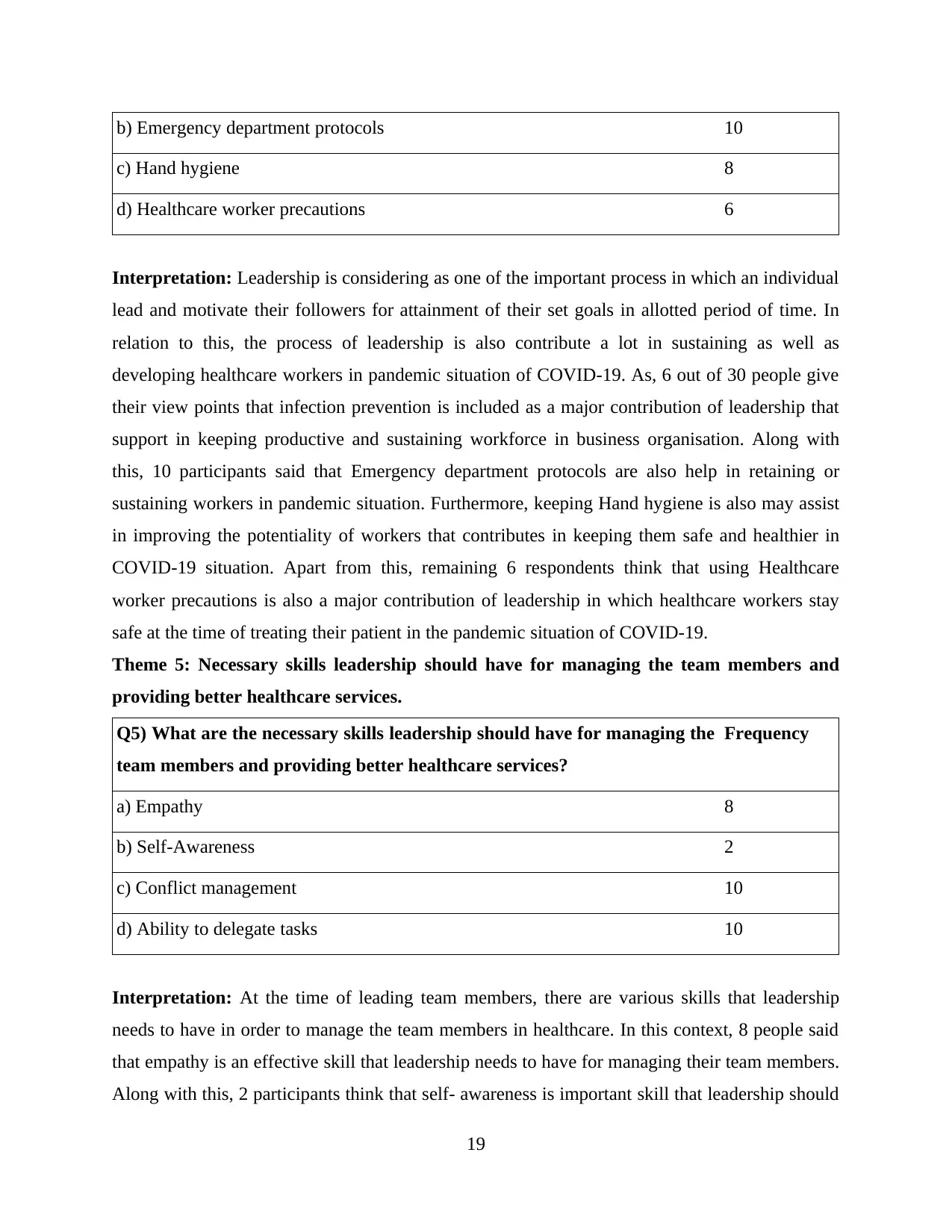
b) Emergency department protocols 10
c) Hand hygiene 8
d) Healthcare worker precautions 6
Interpretation: Leadership is considering as one of the important process in which an individual
lead and motivate their followers for attainment of their set goals in allotted period of time. In
relation to this, the process of leadership is also contribute a lot in sustaining as well as
developing healthcare workers in pandemic situation of COVID-19. As, 6 out of 30 people give
their view points that infection prevention is included as a major contribution of leadership that
support in keeping productive and sustaining workforce in business organisation. Along with
this, 10 participants said that Emergency department protocols are also help in retaining or
sustaining workers in pandemic situation. Furthermore, keeping Hand hygiene is also may assist
in improving the potentiality of workers that contributes in keeping them safe and healthier in
COVID-19 situation. Apart from this, remaining 6 respondents think that using Healthcare
worker precautions is also a major contribution of leadership in which healthcare workers stay
safe at the time of treating their patient in the pandemic situation of COVID-19.
Theme 5: Necessary skills leadership should have for managing the team members and
providing better healthcare services.
Q5) What are the necessary skills leadership should have for managing the
team members and providing better healthcare services?
Frequency
a) Empathy 8
b) Self-Awareness 2
c) Conflict management 10
d) Ability to delegate tasks 10
Interpretation: At the time of leading team members, there are various skills that leadership
needs to have in order to manage the team members in healthcare. In this context, 8 people said
that empathy is an effective skill that leadership needs to have for managing their team members.
Along with this, 2 participants think that self- awareness is important skill that leadership should
19
c) Hand hygiene 8
d) Healthcare worker precautions 6
Interpretation: Leadership is considering as one of the important process in which an individual
lead and motivate their followers for attainment of their set goals in allotted period of time. In
relation to this, the process of leadership is also contribute a lot in sustaining as well as
developing healthcare workers in pandemic situation of COVID-19. As, 6 out of 30 people give
their view points that infection prevention is included as a major contribution of leadership that
support in keeping productive and sustaining workforce in business organisation. Along with
this, 10 participants said that Emergency department protocols are also help in retaining or
sustaining workers in pandemic situation. Furthermore, keeping Hand hygiene is also may assist
in improving the potentiality of workers that contributes in keeping them safe and healthier in
COVID-19 situation. Apart from this, remaining 6 respondents think that using Healthcare
worker precautions is also a major contribution of leadership in which healthcare workers stay
safe at the time of treating their patient in the pandemic situation of COVID-19.
Theme 5: Necessary skills leadership should have for managing the team members and
providing better healthcare services.
Q5) What are the necessary skills leadership should have for managing the
team members and providing better healthcare services?
Frequency
a) Empathy 8
b) Self-Awareness 2
c) Conflict management 10
d) Ability to delegate tasks 10
Interpretation: At the time of leading team members, there are various skills that leadership
needs to have in order to manage the team members in healthcare. In this context, 8 people said
that empathy is an effective skill that leadership needs to have for managing their team members.
Along with this, 2 participants think that self- awareness is important skill that leadership should
19
Secure Best Marks with AI Grader
Need help grading? Try our AI Grader for instant feedback on your assignments.
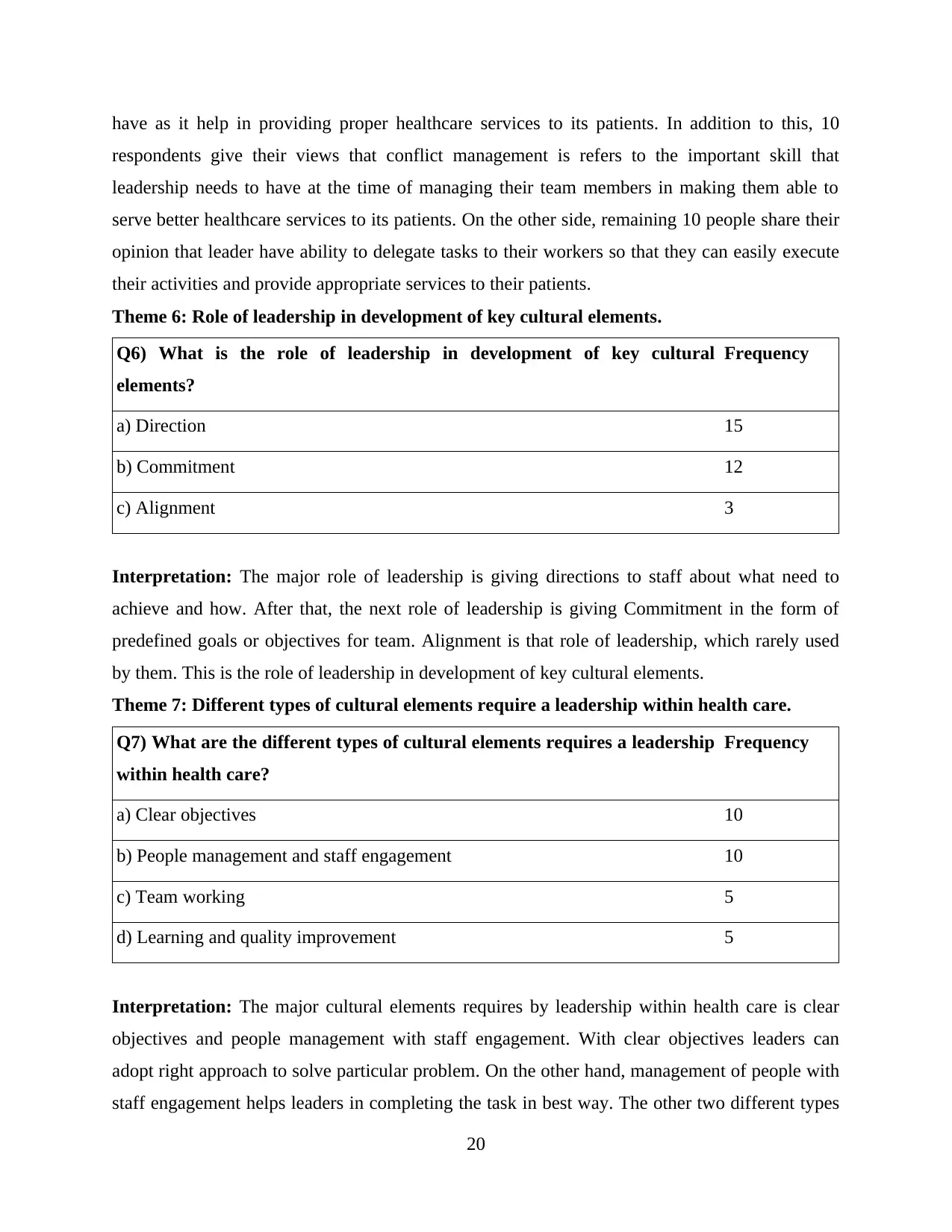
have as it help in providing proper healthcare services to its patients. In addition to this, 10
respondents give their views that conflict management is refers to the important skill that
leadership needs to have at the time of managing their team members in making them able to
serve better healthcare services to its patients. On the other side, remaining 10 people share their
opinion that leader have ability to delegate tasks to their workers so that they can easily execute
their activities and provide appropriate services to their patients.
Theme 6: Role of leadership in development of key cultural elements.
Q6) What is the role of leadership in development of key cultural
elements?
Frequency
a) Direction 15
b) Commitment 12
c) Alignment 3
Interpretation: The major role of leadership is giving directions to staff about what need to
achieve and how. After that, the next role of leadership is giving Commitment in the form of
predefined goals or objectives for team. Alignment is that role of leadership, which rarely used
by them. This is the role of leadership in development of key cultural elements.
Theme 7: Different types of cultural elements require a leadership within health care.
Q7) What are the different types of cultural elements requires a leadership
within health care?
Frequency
a) Clear objectives 10
b) People management and staff engagement 10
c) Team working 5
d) Learning and quality improvement 5
Interpretation: The major cultural elements requires by leadership within health care is clear
objectives and people management with staff engagement. With clear objectives leaders can
adopt right approach to solve particular problem. On the other hand, management of people with
staff engagement helps leaders in completing the task in best way. The other two different types
20
respondents give their views that conflict management is refers to the important skill that
leadership needs to have at the time of managing their team members in making them able to
serve better healthcare services to its patients. On the other side, remaining 10 people share their
opinion that leader have ability to delegate tasks to their workers so that they can easily execute
their activities and provide appropriate services to their patients.
Theme 6: Role of leadership in development of key cultural elements.
Q6) What is the role of leadership in development of key cultural
elements?
Frequency
a) Direction 15
b) Commitment 12
c) Alignment 3
Interpretation: The major role of leadership is giving directions to staff about what need to
achieve and how. After that, the next role of leadership is giving Commitment in the form of
predefined goals or objectives for team. Alignment is that role of leadership, which rarely used
by them. This is the role of leadership in development of key cultural elements.
Theme 7: Different types of cultural elements require a leadership within health care.
Q7) What are the different types of cultural elements requires a leadership
within health care?
Frequency
a) Clear objectives 10
b) People management and staff engagement 10
c) Team working 5
d) Learning and quality improvement 5
Interpretation: The major cultural elements requires by leadership within health care is clear
objectives and people management with staff engagement. With clear objectives leaders can
adopt right approach to solve particular problem. On the other hand, management of people with
staff engagement helps leaders in completing the task in best way. The other two different types
20
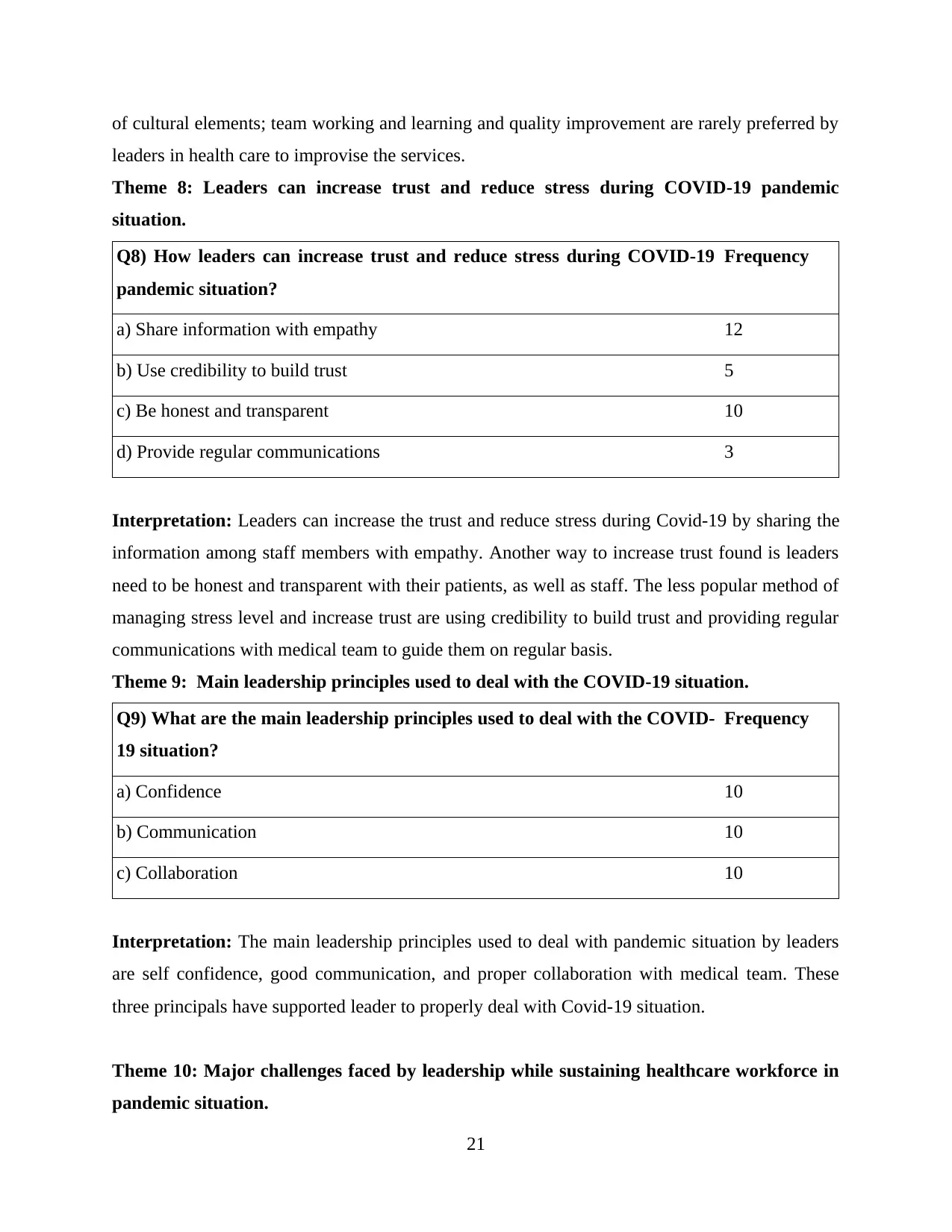
of cultural elements; team working and learning and quality improvement are rarely preferred by
leaders in health care to improvise the services.
Theme 8: Leaders can increase trust and reduce stress during COVID-19 pandemic
situation.
Q8) How leaders can increase trust and reduce stress during COVID-19
pandemic situation?
Frequency
a) Share information with empathy 12
b) Use credibility to build trust 5
c) Be honest and transparent 10
d) Provide regular communications 3
Interpretation: Leaders can increase the trust and reduce stress during Covid-19 by sharing the
information among staff members with empathy. Another way to increase trust found is leaders
need to be honest and transparent with their patients, as well as staff. The less popular method of
managing stress level and increase trust are using credibility to build trust and providing regular
communications with medical team to guide them on regular basis.
Theme 9: Main leadership principles used to deal with the COVID-19 situation.
Q9) What are the main leadership principles used to deal with the COVID-
19 situation?
Frequency
a) Confidence 10
b) Communication 10
c) Collaboration 10
Interpretation: The main leadership principles used to deal with pandemic situation by leaders
are self confidence, good communication, and proper collaboration with medical team. These
three principals have supported leader to properly deal with Covid-19 situation.
Theme 10: Major challenges faced by leadership while sustaining healthcare workforce in
pandemic situation.
21
leaders in health care to improvise the services.
Theme 8: Leaders can increase trust and reduce stress during COVID-19 pandemic
situation.
Q8) How leaders can increase trust and reduce stress during COVID-19
pandemic situation?
Frequency
a) Share information with empathy 12
b) Use credibility to build trust 5
c) Be honest and transparent 10
d) Provide regular communications 3
Interpretation: Leaders can increase the trust and reduce stress during Covid-19 by sharing the
information among staff members with empathy. Another way to increase trust found is leaders
need to be honest and transparent with their patients, as well as staff. The less popular method of
managing stress level and increase trust are using credibility to build trust and providing regular
communications with medical team to guide them on regular basis.
Theme 9: Main leadership principles used to deal with the COVID-19 situation.
Q9) What are the main leadership principles used to deal with the COVID-
19 situation?
Frequency
a) Confidence 10
b) Communication 10
c) Collaboration 10
Interpretation: The main leadership principles used to deal with pandemic situation by leaders
are self confidence, good communication, and proper collaboration with medical team. These
three principals have supported leader to properly deal with Covid-19 situation.
Theme 10: Major challenges faced by leadership while sustaining healthcare workforce in
pandemic situation.
21
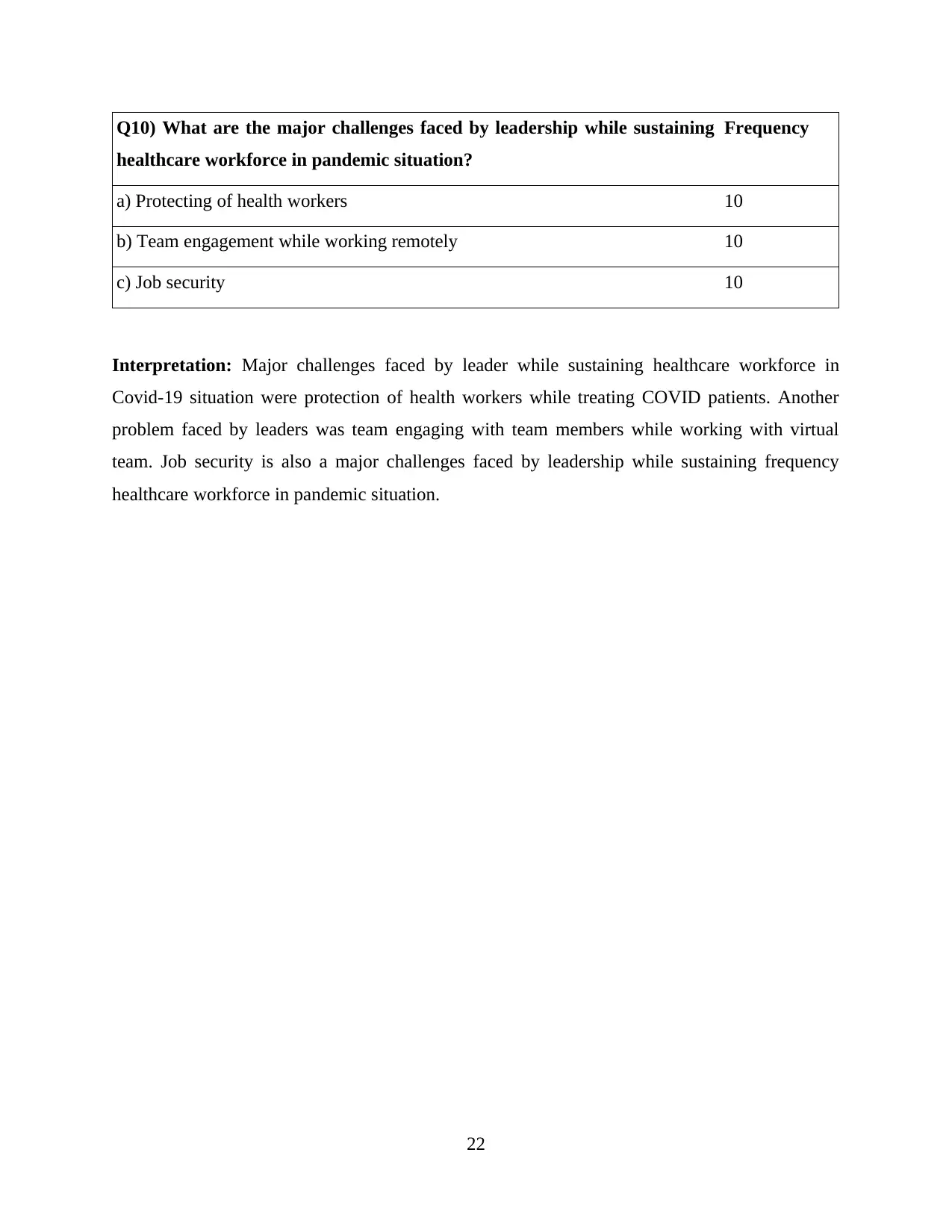
Q10) What are the major challenges faced by leadership while sustaining
healthcare workforce in pandemic situation?
Frequency
a) Protecting of health workers 10
b) Team engagement while working remotely 10
c) Job security 10
Interpretation: Major challenges faced by leader while sustaining healthcare workforce in
Covid-19 situation were protection of health workers while treating COVID patients. Another
problem faced by leaders was team engaging with team members while working with virtual
team. Job security is also a major challenges faced by leadership while sustaining frequency
healthcare workforce in pandemic situation.
22
healthcare workforce in pandemic situation?
Frequency
a) Protecting of health workers 10
b) Team engagement while working remotely 10
c) Job security 10
Interpretation: Major challenges faced by leader while sustaining healthcare workforce in
Covid-19 situation were protection of health workers while treating COVID patients. Another
problem faced by leaders was team engaging with team members while working with virtual
team. Job security is also a major challenges faced by leadership while sustaining frequency
healthcare workforce in pandemic situation.
22
Paraphrase This Document
Need a fresh take? Get an instant paraphrase of this document with our AI Paraphraser
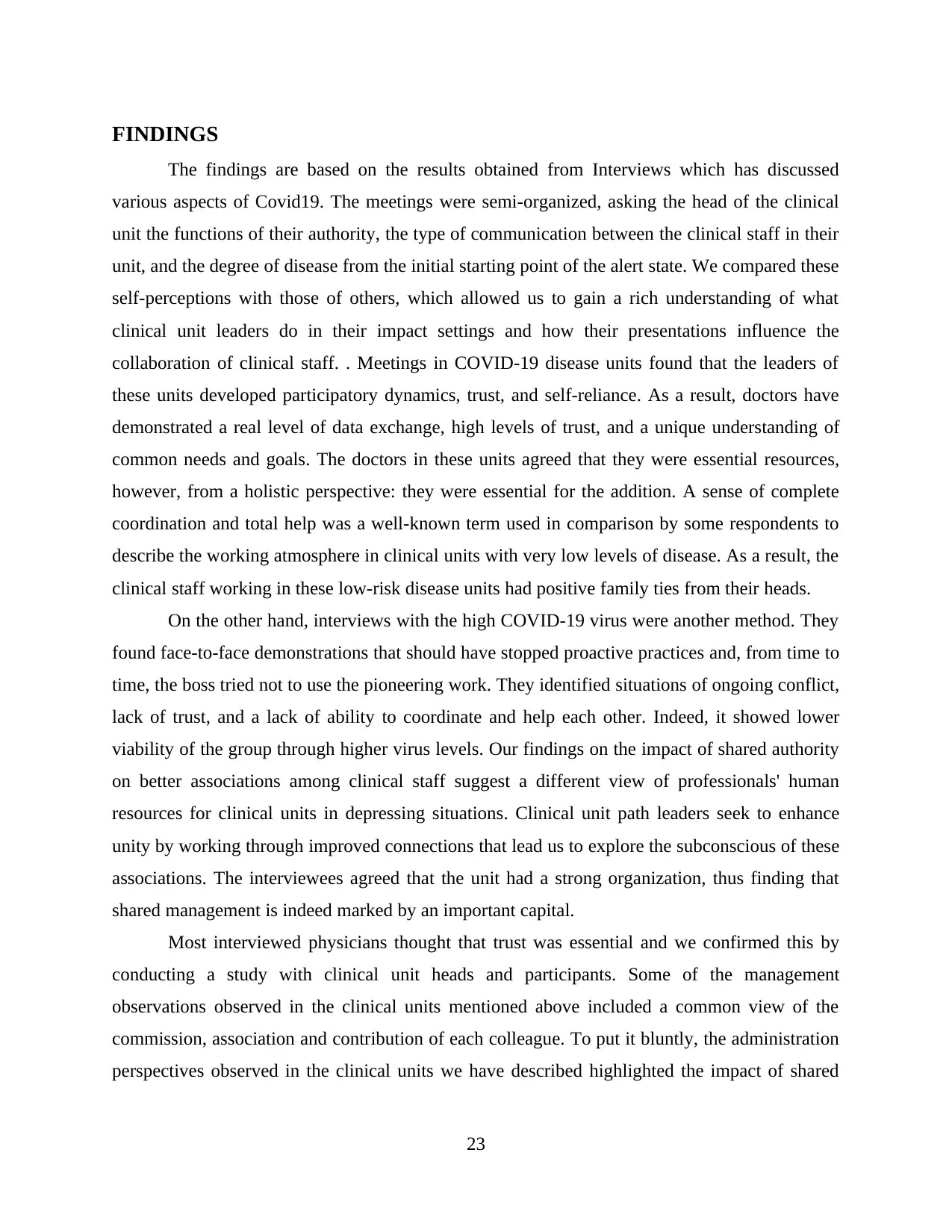
FINDINGS
The findings are based on the results obtained from Interviews which has discussed
various aspects of Covid19. The meetings were semi-organized, asking the head of the clinical
unit the functions of their authority, the type of communication between the clinical staff in their
unit, and the degree of disease from the initial starting point of the alert state. We compared these
self-perceptions with those of others, which allowed us to gain a rich understanding of what
clinical unit leaders do in their impact settings and how their presentations influence the
collaboration of clinical staff. . Meetings in COVID-19 disease units found that the leaders of
these units developed participatory dynamics, trust, and self-reliance. As a result, doctors have
demonstrated a real level of data exchange, high levels of trust, and a unique understanding of
common needs and goals. The doctors in these units agreed that they were essential resources,
however, from a holistic perspective: they were essential for the addition. A sense of complete
coordination and total help was a well-known term used in comparison by some respondents to
describe the working atmosphere in clinical units with very low levels of disease. As a result, the
clinical staff working in these low-risk disease units had positive family ties from their heads.
On the other hand, interviews with the high COVID-19 virus were another method. They
found face-to-face demonstrations that should have stopped proactive practices and, from time to
time, the boss tried not to use the pioneering work. They identified situations of ongoing conflict,
lack of trust, and a lack of ability to coordinate and help each other. Indeed, it showed lower
viability of the group through higher virus levels. Our findings on the impact of shared authority
on better associations among clinical staff suggest a different view of professionals' human
resources for clinical units in depressing situations. Clinical unit path leaders seek to enhance
unity by working through improved connections that lead us to explore the subconscious of these
associations. The interviewees agreed that the unit had a strong organization, thus finding that
shared management is indeed marked by an important capital.
Most interviewed physicians thought that trust was essential and we confirmed this by
conducting a study with clinical unit heads and participants. Some of the management
observations observed in the clinical units mentioned above included a common view of the
commission, association and contribution of each colleague. To put it bluntly, the administration
perspectives observed in the clinical units we have described highlighted the impact of shared
23
The findings are based on the results obtained from Interviews which has discussed
various aspects of Covid19. The meetings were semi-organized, asking the head of the clinical
unit the functions of their authority, the type of communication between the clinical staff in their
unit, and the degree of disease from the initial starting point of the alert state. We compared these
self-perceptions with those of others, which allowed us to gain a rich understanding of what
clinical unit leaders do in their impact settings and how their presentations influence the
collaboration of clinical staff. . Meetings in COVID-19 disease units found that the leaders of
these units developed participatory dynamics, trust, and self-reliance. As a result, doctors have
demonstrated a real level of data exchange, high levels of trust, and a unique understanding of
common needs and goals. The doctors in these units agreed that they were essential resources,
however, from a holistic perspective: they were essential for the addition. A sense of complete
coordination and total help was a well-known term used in comparison by some respondents to
describe the working atmosphere in clinical units with very low levels of disease. As a result, the
clinical staff working in these low-risk disease units had positive family ties from their heads.
On the other hand, interviews with the high COVID-19 virus were another method. They
found face-to-face demonstrations that should have stopped proactive practices and, from time to
time, the boss tried not to use the pioneering work. They identified situations of ongoing conflict,
lack of trust, and a lack of ability to coordinate and help each other. Indeed, it showed lower
viability of the group through higher virus levels. Our findings on the impact of shared authority
on better associations among clinical staff suggest a different view of professionals' human
resources for clinical units in depressing situations. Clinical unit path leaders seek to enhance
unity by working through improved connections that lead us to explore the subconscious of these
associations. The interviewees agreed that the unit had a strong organization, thus finding that
shared management is indeed marked by an important capital.
Most interviewed physicians thought that trust was essential and we confirmed this by
conducting a study with clinical unit heads and participants. Some of the management
observations observed in the clinical units mentioned above included a common view of the
commission, association and contribution of each colleague. To put it bluntly, the administration
perspectives observed in the clinical units we have described highlighted the impact of shared
23
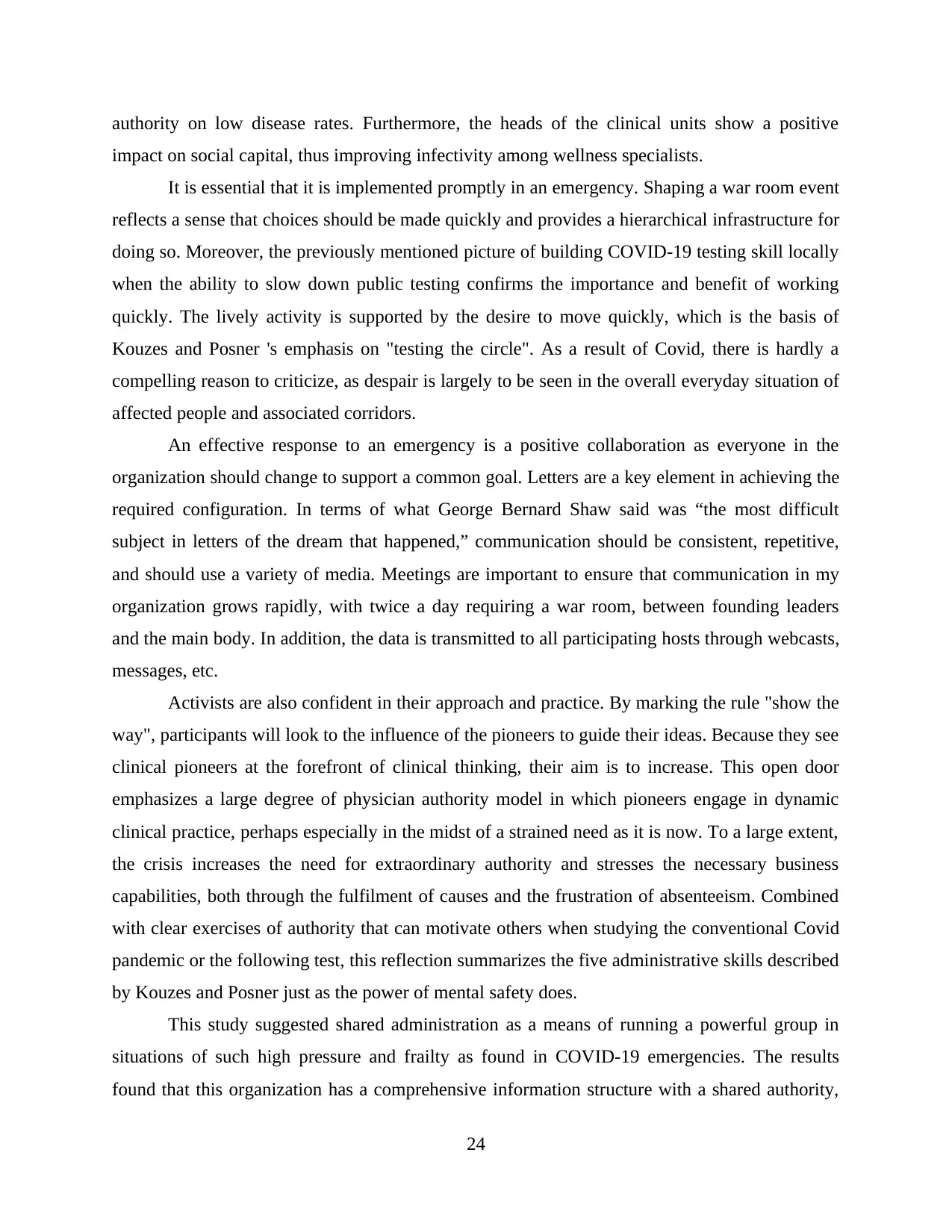
authority on low disease rates. Furthermore, the heads of the clinical units show a positive
impact on social capital, thus improving infectivity among wellness specialists.
It is essential that it is implemented promptly in an emergency. Shaping a war room event
reflects a sense that choices should be made quickly and provides a hierarchical infrastructure for
doing so. Moreover, the previously mentioned picture of building COVID-19 testing skill locally
when the ability to slow down public testing confirms the importance and benefit of working
quickly. The lively activity is supported by the desire to move quickly, which is the basis of
Kouzes and Posner 's emphasis on "testing the circle". As a result of Covid, there is hardly a
compelling reason to criticize, as despair is largely to be seen in the overall everyday situation of
affected people and associated corridors.
An effective response to an emergency is a positive collaboration as everyone in the
organization should change to support a common goal. Letters are a key element in achieving the
required configuration. In terms of what George Bernard Shaw said was “the most difficult
subject in letters of the dream that happened,” communication should be consistent, repetitive,
and should use a variety of media. Meetings are important to ensure that communication in my
organization grows rapidly, with twice a day requiring a war room, between founding leaders
and the main body. In addition, the data is transmitted to all participating hosts through webcasts,
messages, etc.
Activists are also confident in their approach and practice. By marking the rule "show the
way", participants will look to the influence of the pioneers to guide their ideas. Because they see
clinical pioneers at the forefront of clinical thinking, their aim is to increase. This open door
emphasizes a large degree of physician authority model in which pioneers engage in dynamic
clinical practice, perhaps especially in the midst of a strained need as it is now. To a large extent,
the crisis increases the need for extraordinary authority and stresses the necessary business
capabilities, both through the fulfilment of causes and the frustration of absenteeism. Combined
with clear exercises of authority that can motivate others when studying the conventional Covid
pandemic or the following test, this reflection summarizes the five administrative skills described
by Kouzes and Posner just as the power of mental safety does.
This study suggested shared administration as a means of running a powerful group in
situations of such high pressure and frailty as found in COVID-19 emergencies. The results
found that this organization has a comprehensive information structure with a shared authority,
24
impact on social capital, thus improving infectivity among wellness specialists.
It is essential that it is implemented promptly in an emergency. Shaping a war room event
reflects a sense that choices should be made quickly and provides a hierarchical infrastructure for
doing so. Moreover, the previously mentioned picture of building COVID-19 testing skill locally
when the ability to slow down public testing confirms the importance and benefit of working
quickly. The lively activity is supported by the desire to move quickly, which is the basis of
Kouzes and Posner 's emphasis on "testing the circle". As a result of Covid, there is hardly a
compelling reason to criticize, as despair is largely to be seen in the overall everyday situation of
affected people and associated corridors.
An effective response to an emergency is a positive collaboration as everyone in the
organization should change to support a common goal. Letters are a key element in achieving the
required configuration. In terms of what George Bernard Shaw said was “the most difficult
subject in letters of the dream that happened,” communication should be consistent, repetitive,
and should use a variety of media. Meetings are important to ensure that communication in my
organization grows rapidly, with twice a day requiring a war room, between founding leaders
and the main body. In addition, the data is transmitted to all participating hosts through webcasts,
messages, etc.
Activists are also confident in their approach and practice. By marking the rule "show the
way", participants will look to the influence of the pioneers to guide their ideas. Because they see
clinical pioneers at the forefront of clinical thinking, their aim is to increase. This open door
emphasizes a large degree of physician authority model in which pioneers engage in dynamic
clinical practice, perhaps especially in the midst of a strained need as it is now. To a large extent,
the crisis increases the need for extraordinary authority and stresses the necessary business
capabilities, both through the fulfilment of causes and the frustration of absenteeism. Combined
with clear exercises of authority that can motivate others when studying the conventional Covid
pandemic or the following test, this reflection summarizes the five administrative skills described
by Kouzes and Posner just as the power of mental safety does.
This study suggested shared administration as a means of running a powerful group in
situations of such high pressure and frailty as found in COVID-19 emergencies. The results
found that this organization has a comprehensive information structure with a shared authority,
24
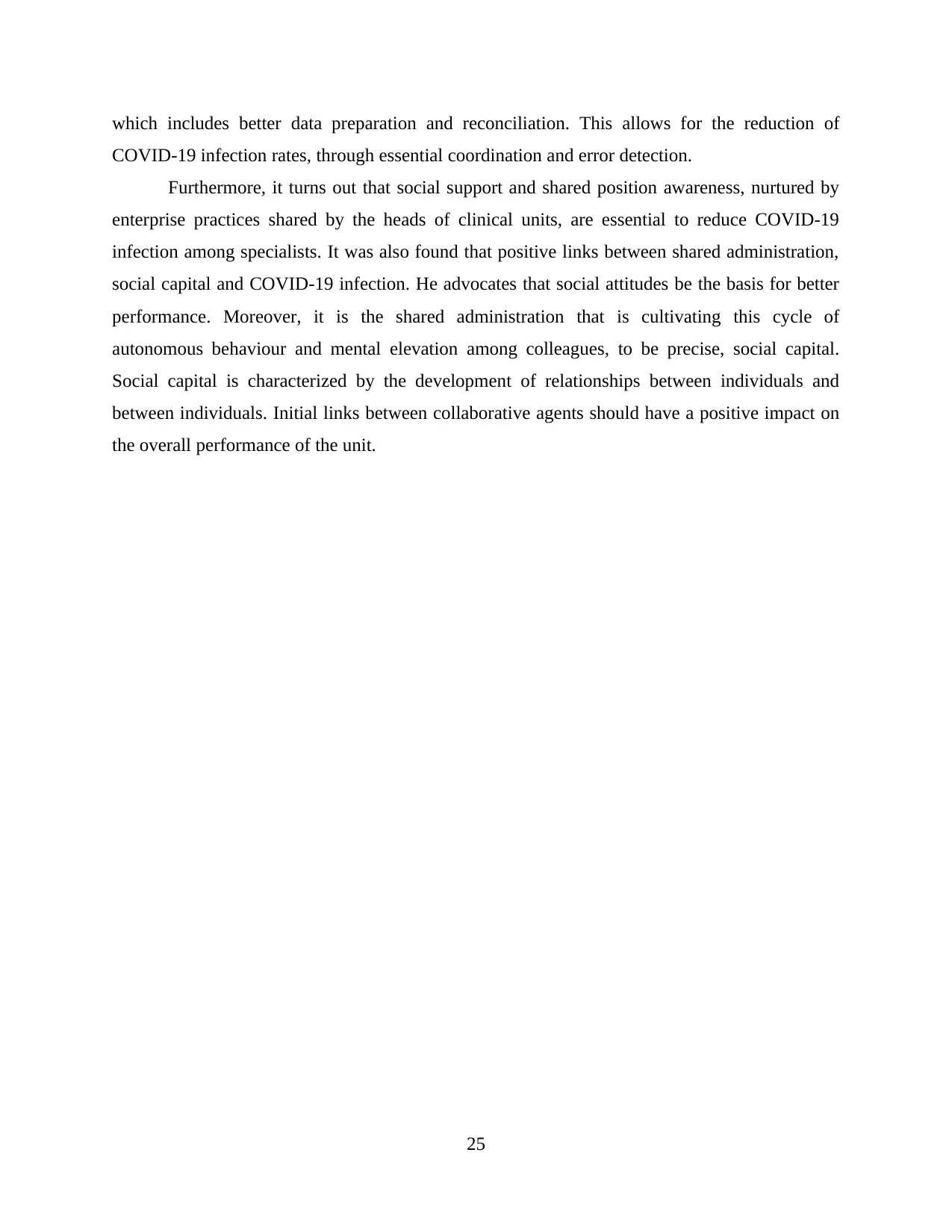
which includes better data preparation and reconciliation. This allows for the reduction of
COVID-19 infection rates, through essential coordination and error detection.
Furthermore, it turns out that social support and shared position awareness, nurtured by
enterprise practices shared by the heads of clinical units, are essential to reduce COVID-19
infection among specialists. It was also found that positive links between shared administration,
social capital and COVID-19 infection. He advocates that social attitudes be the basis for better
performance. Moreover, it is the shared administration that is cultivating this cycle of
autonomous behaviour and mental elevation among colleagues, to be precise, social capital.
Social capital is characterized by the development of relationships between individuals and
between individuals. Initial links between collaborative agents should have a positive impact on
the overall performance of the unit.
25
COVID-19 infection rates, through essential coordination and error detection.
Furthermore, it turns out that social support and shared position awareness, nurtured by
enterprise practices shared by the heads of clinical units, are essential to reduce COVID-19
infection among specialists. It was also found that positive links between shared administration,
social capital and COVID-19 infection. He advocates that social attitudes be the basis for better
performance. Moreover, it is the shared administration that is cultivating this cycle of
autonomous behaviour and mental elevation among colleagues, to be precise, social capital.
Social capital is characterized by the development of relationships between individuals and
between individuals. Initial links between collaborative agents should have a positive impact on
the overall performance of the unit.
25
Secure Best Marks with AI Grader
Need help grading? Try our AI Grader for instant feedback on your assignments.
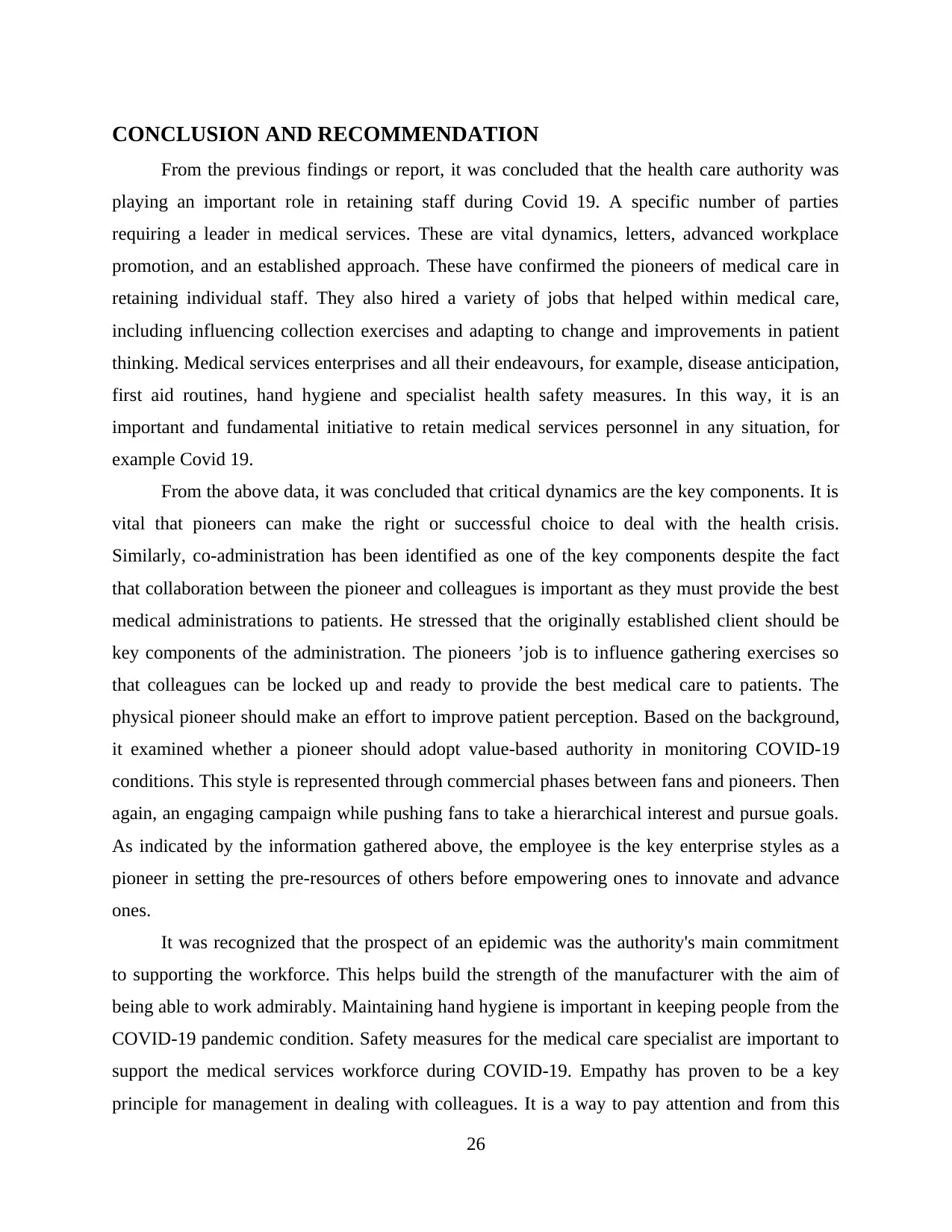
CONCLUSION AND RECOMMENDATION
From the previous findings or report, it was concluded that the health care authority was
playing an important role in retaining staff during Covid 19. A specific number of parties
requiring a leader in medical services. These are vital dynamics, letters, advanced workplace
promotion, and an established approach. These have confirmed the pioneers of medical care in
retaining individual staff. They also hired a variety of jobs that helped within medical care,
including influencing collection exercises and adapting to change and improvements in patient
thinking. Medical services enterprises and all their endeavours, for example, disease anticipation,
first aid routines, hand hygiene and specialist health safety measures. In this way, it is an
important and fundamental initiative to retain medical services personnel in any situation, for
example Covid 19.
From the above data, it was concluded that critical dynamics are the key components. It is
vital that pioneers can make the right or successful choice to deal with the health crisis.
Similarly, co-administration has been identified as one of the key components despite the fact
that collaboration between the pioneer and colleagues is important as they must provide the best
medical administrations to patients. He stressed that the originally established client should be
key components of the administration. The pioneers ’job is to influence gathering exercises so
that colleagues can be locked up and ready to provide the best medical care to patients. The
physical pioneer should make an effort to improve patient perception. Based on the background,
it examined whether a pioneer should adopt value-based authority in monitoring COVID-19
conditions. This style is represented through commercial phases between fans and pioneers. Then
again, an engaging campaign while pushing fans to take a hierarchical interest and pursue goals.
As indicated by the information gathered above, the employee is the key enterprise styles as a
pioneer in setting the pre-resources of others before empowering ones to innovate and advance
ones.
It was recognized that the prospect of an epidemic was the authority's main commitment
to supporting the workforce. This helps build the strength of the manufacturer with the aim of
being able to work admirably. Maintaining hand hygiene is important in keeping people from the
COVID-19 pandemic condition. Safety measures for the medical care specialist are important to
support the medical services workforce during COVID-19. Empathy has proven to be a key
principle for management in dealing with colleagues. It is a way to pay attention and from this
26
From the previous findings or report, it was concluded that the health care authority was
playing an important role in retaining staff during Covid 19. A specific number of parties
requiring a leader in medical services. These are vital dynamics, letters, advanced workplace
promotion, and an established approach. These have confirmed the pioneers of medical care in
retaining individual staff. They also hired a variety of jobs that helped within medical care,
including influencing collection exercises and adapting to change and improvements in patient
thinking. Medical services enterprises and all their endeavours, for example, disease anticipation,
first aid routines, hand hygiene and specialist health safety measures. In this way, it is an
important and fundamental initiative to retain medical services personnel in any situation, for
example Covid 19.
From the above data, it was concluded that critical dynamics are the key components. It is
vital that pioneers can make the right or successful choice to deal with the health crisis.
Similarly, co-administration has been identified as one of the key components despite the fact
that collaboration between the pioneer and colleagues is important as they must provide the best
medical administrations to patients. He stressed that the originally established client should be
key components of the administration. The pioneers ’job is to influence gathering exercises so
that colleagues can be locked up and ready to provide the best medical care to patients. The
physical pioneer should make an effort to improve patient perception. Based on the background,
it examined whether a pioneer should adopt value-based authority in monitoring COVID-19
conditions. This style is represented through commercial phases between fans and pioneers. Then
again, an engaging campaign while pushing fans to take a hierarchical interest and pursue goals.
As indicated by the information gathered above, the employee is the key enterprise styles as a
pioneer in setting the pre-resources of others before empowering ones to innovate and advance
ones.
It was recognized that the prospect of an epidemic was the authority's main commitment
to supporting the workforce. This helps build the strength of the manufacturer with the aim of
being able to work admirably. Maintaining hand hygiene is important in keeping people from the
COVID-19 pandemic condition. Safety measures for the medical care specialist are important to
support the medical services workforce during COVID-19. Empathy has proven to be a key
principle for management in dealing with colleagues. It is a way to pay attention and from this
26
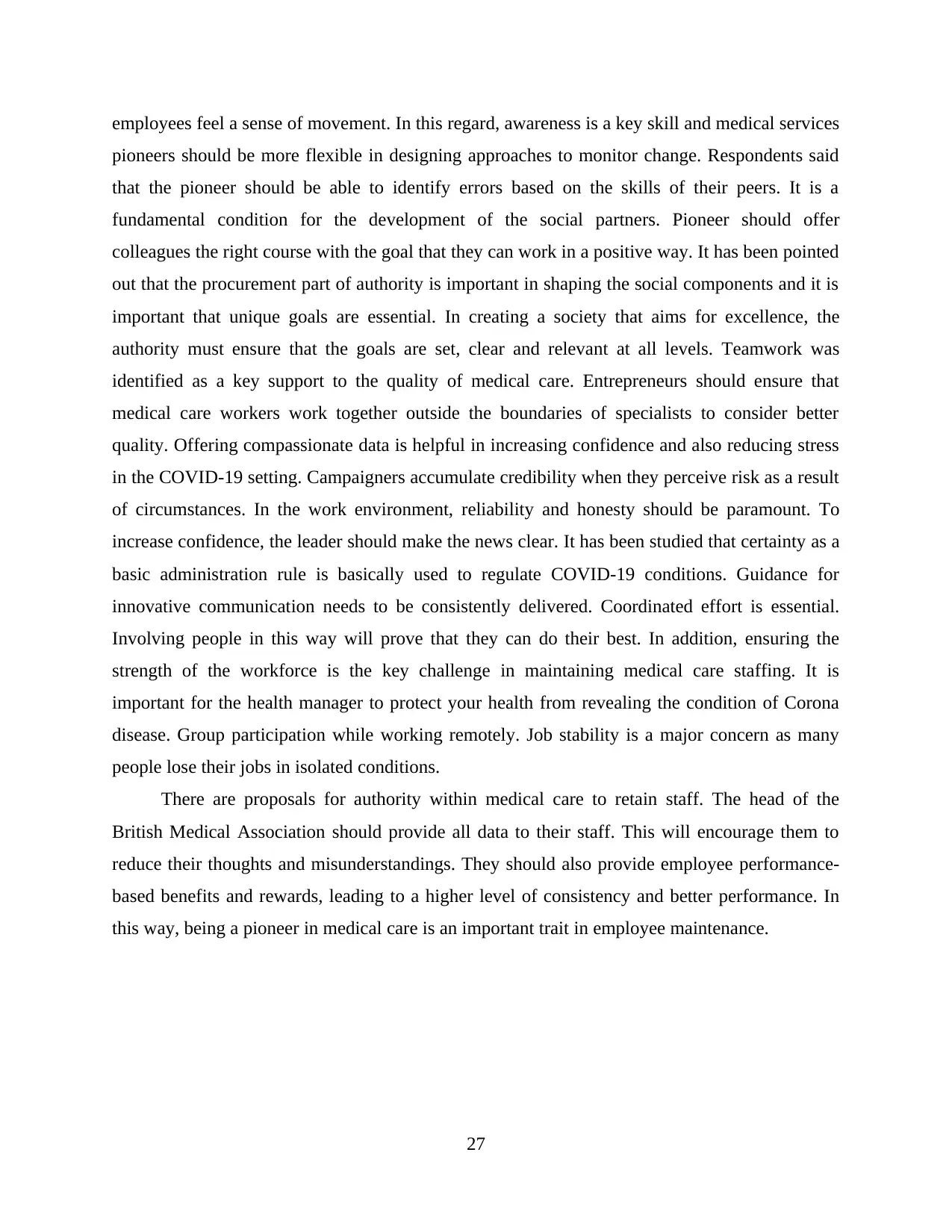
employees feel a sense of movement. In this regard, awareness is a key skill and medical services
pioneers should be more flexible in designing approaches to monitor change. Respondents said
that the pioneer should be able to identify errors based on the skills of their peers. It is a
fundamental condition for the development of the social partners. Pioneer should offer
colleagues the right course with the goal that they can work in a positive way. It has been pointed
out that the procurement part of authority is important in shaping the social components and it is
important that unique goals are essential. In creating a society that aims for excellence, the
authority must ensure that the goals are set, clear and relevant at all levels. Teamwork was
identified as a key support to the quality of medical care. Entrepreneurs should ensure that
medical care workers work together outside the boundaries of specialists to consider better
quality. Offering compassionate data is helpful in increasing confidence and also reducing stress
in the COVID-19 setting. Campaigners accumulate credibility when they perceive risk as a result
of circumstances. In the work environment, reliability and honesty should be paramount. To
increase confidence, the leader should make the news clear. It has been studied that certainty as a
basic administration rule is basically used to regulate COVID-19 conditions. Guidance for
innovative communication needs to be consistently delivered. Coordinated effort is essential.
Involving people in this way will prove that they can do their best. In addition, ensuring the
strength of the workforce is the key challenge in maintaining medical care staffing. It is
important for the health manager to protect your health from revealing the condition of Corona
disease. Group participation while working remotely. Job stability is a major concern as many
people lose their jobs in isolated conditions.
There are proposals for authority within medical care to retain staff. The head of the
British Medical Association should provide all data to their staff. This will encourage them to
reduce their thoughts and misunderstandings. They should also provide employee performance-
based benefits and rewards, leading to a higher level of consistency and better performance. In
this way, being a pioneer in medical care is an important trait in employee maintenance.
27
pioneers should be more flexible in designing approaches to monitor change. Respondents said
that the pioneer should be able to identify errors based on the skills of their peers. It is a
fundamental condition for the development of the social partners. Pioneer should offer
colleagues the right course with the goal that they can work in a positive way. It has been pointed
out that the procurement part of authority is important in shaping the social components and it is
important that unique goals are essential. In creating a society that aims for excellence, the
authority must ensure that the goals are set, clear and relevant at all levels. Teamwork was
identified as a key support to the quality of medical care. Entrepreneurs should ensure that
medical care workers work together outside the boundaries of specialists to consider better
quality. Offering compassionate data is helpful in increasing confidence and also reducing stress
in the COVID-19 setting. Campaigners accumulate credibility when they perceive risk as a result
of circumstances. In the work environment, reliability and honesty should be paramount. To
increase confidence, the leader should make the news clear. It has been studied that certainty as a
basic administration rule is basically used to regulate COVID-19 conditions. Guidance for
innovative communication needs to be consistently delivered. Coordinated effort is essential.
Involving people in this way will prove that they can do their best. In addition, ensuring the
strength of the workforce is the key challenge in maintaining medical care staffing. It is
important for the health manager to protect your health from revealing the condition of Corona
disease. Group participation while working remotely. Job stability is a major concern as many
people lose their jobs in isolated conditions.
There are proposals for authority within medical care to retain staff. The head of the
British Medical Association should provide all data to their staff. This will encourage them to
reduce their thoughts and misunderstandings. They should also provide employee performance-
based benefits and rewards, leading to a higher level of consistency and better performance. In
this way, being a pioneer in medical care is an important trait in employee maintenance.
27
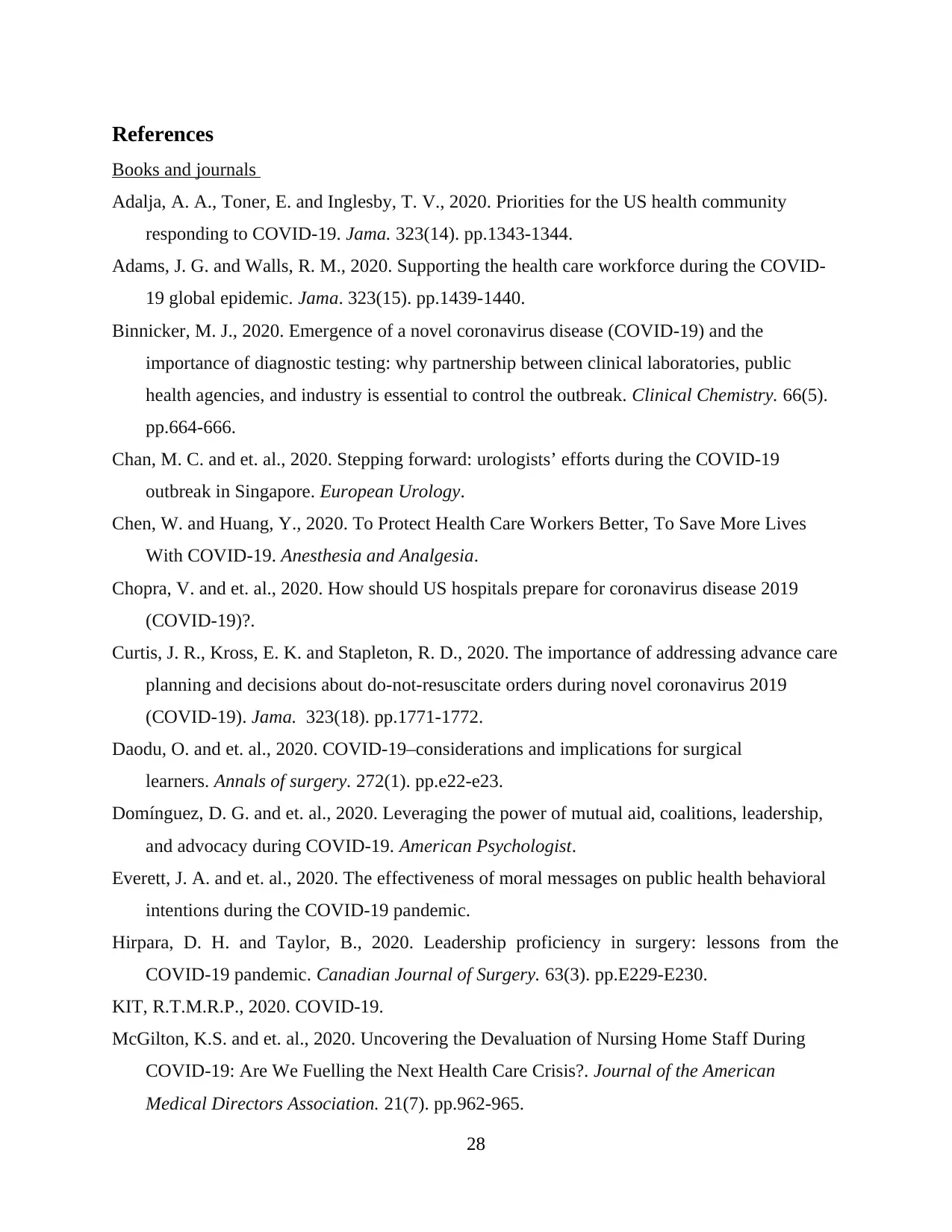
References
Books and journals
Adalja, A. A., Toner, E. and Inglesby, T. V., 2020. Priorities for the US health community
responding to COVID-19. Jama. 323(14). pp.1343-1344.
Adams, J. G. and Walls, R. M., 2020. Supporting the health care workforce during the COVID-
19 global epidemic. Jama. 323(15). pp.1439-1440.
Binnicker, M. J., 2020. Emergence of a novel coronavirus disease (COVID-19) and the
importance of diagnostic testing: why partnership between clinical laboratories, public
health agencies, and industry is essential to control the outbreak. Clinical Chemistry. 66(5).
pp.664-666.
Chan, M. C. and et. al., 2020. Stepping forward: urologists’ efforts during the COVID-19
outbreak in Singapore. European Urology.
Chen, W. and Huang, Y., 2020. To Protect Health Care Workers Better, To Save More Lives
With COVID-19. Anesthesia and Analgesia.
Chopra, V. and et. al., 2020. How should US hospitals prepare for coronavirus disease 2019
(COVID-19)?.
Curtis, J. R., Kross, E. K. and Stapleton, R. D., 2020. The importance of addressing advance care
planning and decisions about do-not-resuscitate orders during novel coronavirus 2019
(COVID-19). Jama. 323(18). pp.1771-1772.
Daodu, O. and et. al., 2020. COVID-19–considerations and implications for surgical
learners. Annals of surgery. 272(1). pp.e22-e23.
Domínguez, D. G. and et. al., 2020. Leveraging the power of mutual aid, coalitions, leadership,
and advocacy during COVID-19. American Psychologist.
Everett, J. A. and et. al., 2020. The effectiveness of moral messages on public health behavioral
intentions during the COVID-19 pandemic.
Hirpara, D. H. and Taylor, B., 2020. Leadership proficiency in surgery: lessons from the
COVID-19 pandemic. Canadian Journal of Surgery. 63(3). pp.E229-E230.
KIT, R.T.M.R.P., 2020. COVID-19.
McGilton, K.S. and et. al., 2020. Uncovering the Devaluation of Nursing Home Staff During
COVID-19: Are We Fuelling the Next Health Care Crisis?. Journal of the American
Medical Directors Association. 21(7). pp.962-965.
28
Books and journals
Adalja, A. A., Toner, E. and Inglesby, T. V., 2020. Priorities for the US health community
responding to COVID-19. Jama. 323(14). pp.1343-1344.
Adams, J. G. and Walls, R. M., 2020. Supporting the health care workforce during the COVID-
19 global epidemic. Jama. 323(15). pp.1439-1440.
Binnicker, M. J., 2020. Emergence of a novel coronavirus disease (COVID-19) and the
importance of diagnostic testing: why partnership between clinical laboratories, public
health agencies, and industry is essential to control the outbreak. Clinical Chemistry. 66(5).
pp.664-666.
Chan, M. C. and et. al., 2020. Stepping forward: urologists’ efforts during the COVID-19
outbreak in Singapore. European Urology.
Chen, W. and Huang, Y., 2020. To Protect Health Care Workers Better, To Save More Lives
With COVID-19. Anesthesia and Analgesia.
Chopra, V. and et. al., 2020. How should US hospitals prepare for coronavirus disease 2019
(COVID-19)?.
Curtis, J. R., Kross, E. K. and Stapleton, R. D., 2020. The importance of addressing advance care
planning and decisions about do-not-resuscitate orders during novel coronavirus 2019
(COVID-19). Jama. 323(18). pp.1771-1772.
Daodu, O. and et. al., 2020. COVID-19–considerations and implications for surgical
learners. Annals of surgery. 272(1). pp.e22-e23.
Domínguez, D. G. and et. al., 2020. Leveraging the power of mutual aid, coalitions, leadership,
and advocacy during COVID-19. American Psychologist.
Everett, J. A. and et. al., 2020. The effectiveness of moral messages on public health behavioral
intentions during the COVID-19 pandemic.
Hirpara, D. H. and Taylor, B., 2020. Leadership proficiency in surgery: lessons from the
COVID-19 pandemic. Canadian Journal of Surgery. 63(3). pp.E229-E230.
KIT, R.T.M.R.P., 2020. COVID-19.
McGilton, K.S. and et. al., 2020. Uncovering the Devaluation of Nursing Home Staff During
COVID-19: Are We Fuelling the Next Health Care Crisis?. Journal of the American
Medical Directors Association. 21(7). pp.962-965.
28
Paraphrase This Document
Need a fresh take? Get an instant paraphrase of this document with our AI Paraphraser
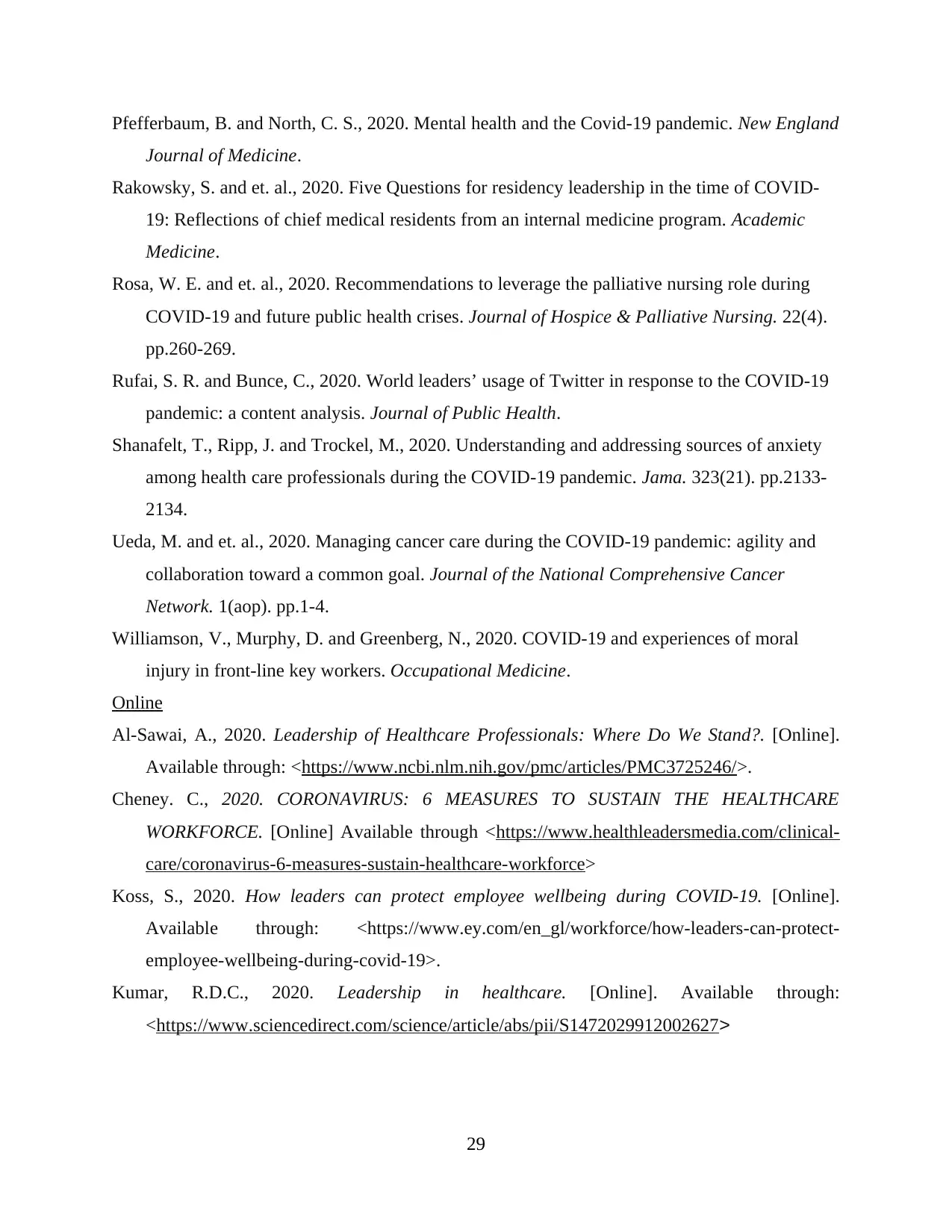
Pfefferbaum, B. and North, C. S., 2020. Mental health and the Covid-19 pandemic. New England
Journal of Medicine.
Rakowsky, S. and et. al., 2020. Five Questions for residency leadership in the time of COVID-
19: Reflections of chief medical residents from an internal medicine program. Academic
Medicine.
Rosa, W. E. and et. al., 2020. Recommendations to leverage the palliative nursing role during
COVID-19 and future public health crises. Journal of Hospice & Palliative Nursing. 22(4).
pp.260-269.
Rufai, S. R. and Bunce, C., 2020. World leaders’ usage of Twitter in response to the COVID-19
pandemic: a content analysis. Journal of Public Health.
Shanafelt, T., Ripp, J. and Trockel, M., 2020. Understanding and addressing sources of anxiety
among health care professionals during the COVID-19 pandemic. Jama. 323(21). pp.2133-
2134.
Ueda, M. and et. al., 2020. Managing cancer care during the COVID-19 pandemic: agility and
collaboration toward a common goal. Journal of the National Comprehensive Cancer
Network. 1(aop). pp.1-4.
Williamson, V., Murphy, D. and Greenberg, N., 2020. COVID-19 and experiences of moral
injury in front-line key workers. Occupational Medicine.
Online
Al-Sawai, A., 2020. Leadership of Healthcare Professionals: Where Do We Stand?. [Online].
Available through: <https://www.ncbi.nlm.nih.gov/pmc/articles/PMC3725246/>.
Cheney. C., 2020. CORONAVIRUS: 6 MEASURES TO SUSTAIN THE HEALTHCARE
WORKFORCE. [Online] Available through <https://www.healthleadersmedia.com/clinical-
care/coronavirus-6-measures-sustain-healthcare-workforce>
Koss, S., 2020. How leaders can protect employee wellbeing during COVID-19. [Online].
Available through: <https://www.ey.com/en_gl/workforce/how-leaders-can-protect-
employee-wellbeing-during-covid-19>.
Kumar, R.D.C., 2020. Leadership in healthcare. [Online]. Available through:
<https://www.sciencedirect.com/science/article/abs/pii/S1472029912002627>
29
Journal of Medicine.
Rakowsky, S. and et. al., 2020. Five Questions for residency leadership in the time of COVID-
19: Reflections of chief medical residents from an internal medicine program. Academic
Medicine.
Rosa, W. E. and et. al., 2020. Recommendations to leverage the palliative nursing role during
COVID-19 and future public health crises. Journal of Hospice & Palliative Nursing. 22(4).
pp.260-269.
Rufai, S. R. and Bunce, C., 2020. World leaders’ usage of Twitter in response to the COVID-19
pandemic: a content analysis. Journal of Public Health.
Shanafelt, T., Ripp, J. and Trockel, M., 2020. Understanding and addressing sources of anxiety
among health care professionals during the COVID-19 pandemic. Jama. 323(21). pp.2133-
2134.
Ueda, M. and et. al., 2020. Managing cancer care during the COVID-19 pandemic: agility and
collaboration toward a common goal. Journal of the National Comprehensive Cancer
Network. 1(aop). pp.1-4.
Williamson, V., Murphy, D. and Greenberg, N., 2020. COVID-19 and experiences of moral
injury in front-line key workers. Occupational Medicine.
Online
Al-Sawai, A., 2020. Leadership of Healthcare Professionals: Where Do We Stand?. [Online].
Available through: <https://www.ncbi.nlm.nih.gov/pmc/articles/PMC3725246/>.
Cheney. C., 2020. CORONAVIRUS: 6 MEASURES TO SUSTAIN THE HEALTHCARE
WORKFORCE. [Online] Available through <https://www.healthleadersmedia.com/clinical-
care/coronavirus-6-measures-sustain-healthcare-workforce>
Koss, S., 2020. How leaders can protect employee wellbeing during COVID-19. [Online].
Available through: <https://www.ey.com/en_gl/workforce/how-leaders-can-protect-
employee-wellbeing-during-covid-19>.
Kumar, R.D.C., 2020. Leadership in healthcare. [Online]. Available through:
<https://www.sciencedirect.com/science/article/abs/pii/S1472029912002627>
29

30
1 out of 33
Related Documents
Your All-in-One AI-Powered Toolkit for Academic Success.
+13062052269
info@desklib.com
Available 24*7 on WhatsApp / Email
![[object Object]](/_next/static/media/star-bottom.7253800d.svg)
Unlock your academic potential
© 2024 | Zucol Services PVT LTD | All rights reserved.



